Trending Today

You Can Now Visit Chernobyl’s Control Room, if You’re Quick About It
Visitors will have five minutes to look around the contaminated spot where the worst nuclear disaster in history took place
Jason Daley
Correspondent
/https://tf-cmsv2-smithsonianmag-media.s3.amazonaws.com/filer/5a/eb/5aeb7028-2e03-4262-bfd3-0facd76a7559/gettyimages-110890564.jpg)
The control room of reactor 4 at the Chernobyl nuclear power plant—one of most ominous places on Earth—has become tourist attraction.
As we reported over the summer , tourism at Chernobyl is booming. And now, as Jack Guy at CNN reports, companies have begun allowing people to briefly visit the highly radioactive control room where the worst nuclear disaster in history unfolded. But they must take precautions: Visitors have to wear protective suits, helmets and masks and are limited to five minutes inside the space. Afterward, they will undergo two mandatory radiology tests to gauge their exposure.
The tour option is part of big changes at the site of the disaster. This July, Ukrainian authorities took charge of the New Safe Confinement dome, which now covers the contaminated reactor building. The massive $1.6 billion structure took 22 years of planning and construction and is expected to safeguard the damaged reactor for 100 years , when experts suggest it may be safe enough to demolish.
The dome is the reason that the area is safe enough to allow more tourism to Chernobyl. Soon after accepting the symbolic keys to the dome, President Volodymyr Zelensky of Ukraine signed a decree designating the site a tourist attraction. “We must give this territory of Ukraine a new life,” Zelensky announced. “Until now, Chernobyl was a negative part of Ukraine's brand. It's time to change it.”
To that end, Ukraine has begun developing new tourist routes and waterways in the area, and will be building and upgrading radiation checkpoints in the area.
The Chernobyl Exclusion Zone has been open to tourists since 2011, according to David Grossman at Popular Mechanics . Earlier this year, researchers found that the 1,000 square mile zone, where humans are not allowed to live, has become a de facto wildlife refuge .
The hit HBO’s miniseries “Chernobyl,” released in May of this year, has led to a tourism boom in the area, with a 30 to 40 percent increase in visitors. “Many people come here, they ask a lot of questions about the TV show, about all the events. People are getting more and more curious,” tour guide Viktoria Brozhko told Max Hunder for Reuters .
Most day-tripping tours visit several abandoned villages, memorials to those who combated the disaster and the now-abandoned city of Pripyat. In total, Brozhko estimates most visitors receive 2 microsieverts of radiation exposure, about the same they’d receive while sitting at home for a day.
Radiation in the control room, however, could be 40,000 times normal levels. While the room remains pretty much as it was in 1986, Brozhko has observed that many plastic control knobs have been removed, likely by decontamination workers and rogue tourists looking for a souvenir.
Chernobyl may now be a tourist attraction, but for many, the spot of the disaster remains an open wound. Because the Soviet Union was unwilling to share data on the nuclear incident, its true toll may never be known. The Soviets claimed 31 people died when the reactor exploded and in the immediate aftermath of the disaster in 1986. As David Brennan at Newsweek reports, in 2008 the U.N. revised that number up to 54. The long-term effects remain hard to quantify. While a multi-agency group called the Chernobyl Forum estimates 4,000 to 9,000 people have or will eventually die from cancer related to Chernobyl exposure, the Union of Concerned Scientists estimates that number is closer to 27,000, and an analysis by Greenpeace suggests the number is closer to 93,000.
Get the latest stories in your inbox every weekday.
Jason Daley | | READ MORE
Jason Daley is a Madison, Wisconsin-based writer specializing in natural history, science, travel, and the environment. His work has appeared in Discover , Popular Science , Outside , Men’s Journal , and other magazines.
Chernobyl’s Reactor No. 4 control room is open to the public for the first time

Oct 9, 2019 • 2 min read
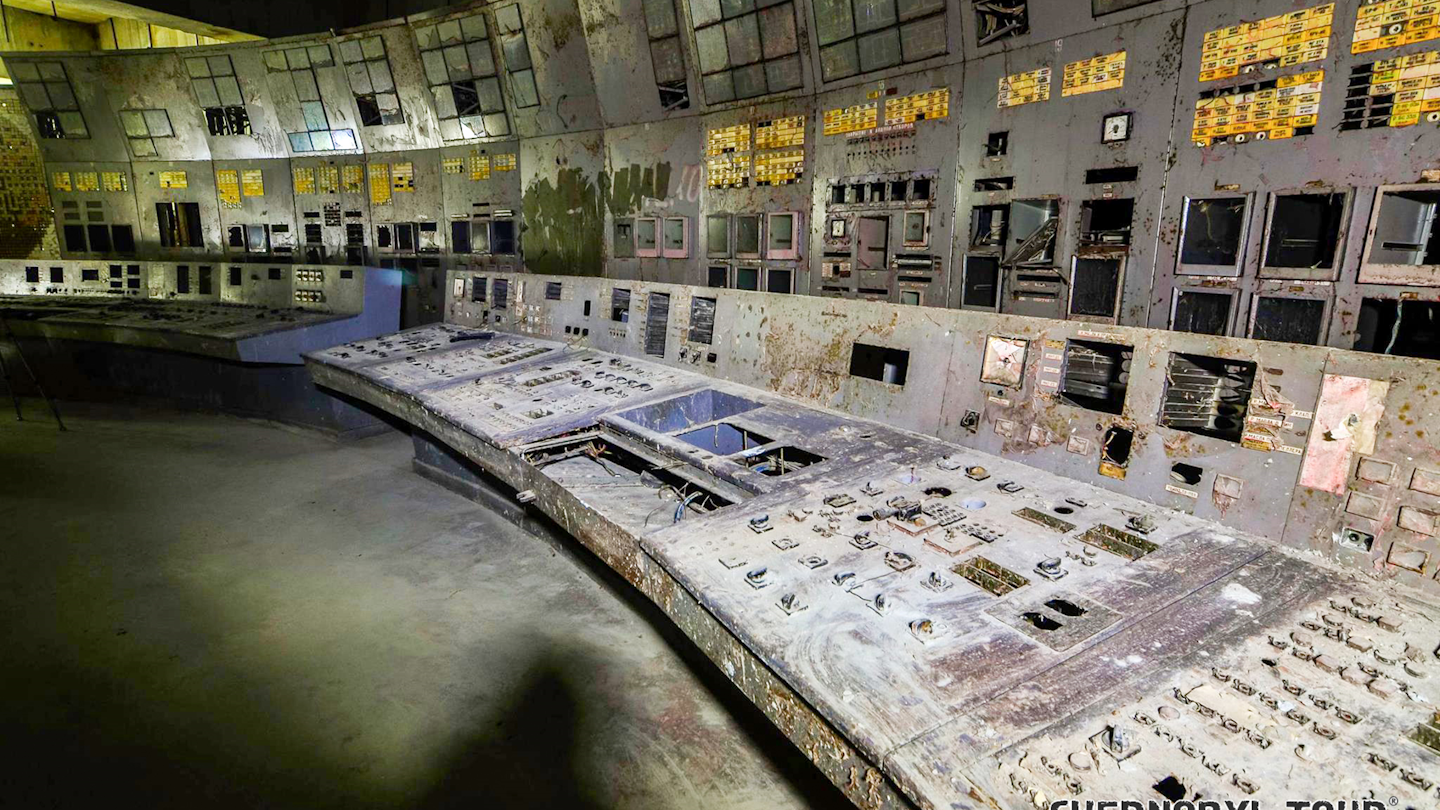
The control room of Chernobyl's highly radioactive Reactor No. 4 is now open to the public ©Chernobyl Tour
Ukraine has opened the control room of Chernobyl reactor four to the public for the first time but visitors must wear a hazmat suit to enter and and be submitted to radiology tests tests when they leave.

The control room of Chernobyl's reactor No. 4 is the epicentre of the worst-ever civil nuclear disaster in history. Thirty-three years ago, on that awful night of 26 April 1986, a series of explosions destroyed the reactor, killing at least 54 people in the immediate aftermath and sending a plume of deadly radioactive dust into the atmosphere, threatening the health and wellbeing of hundreds of thousands of people.
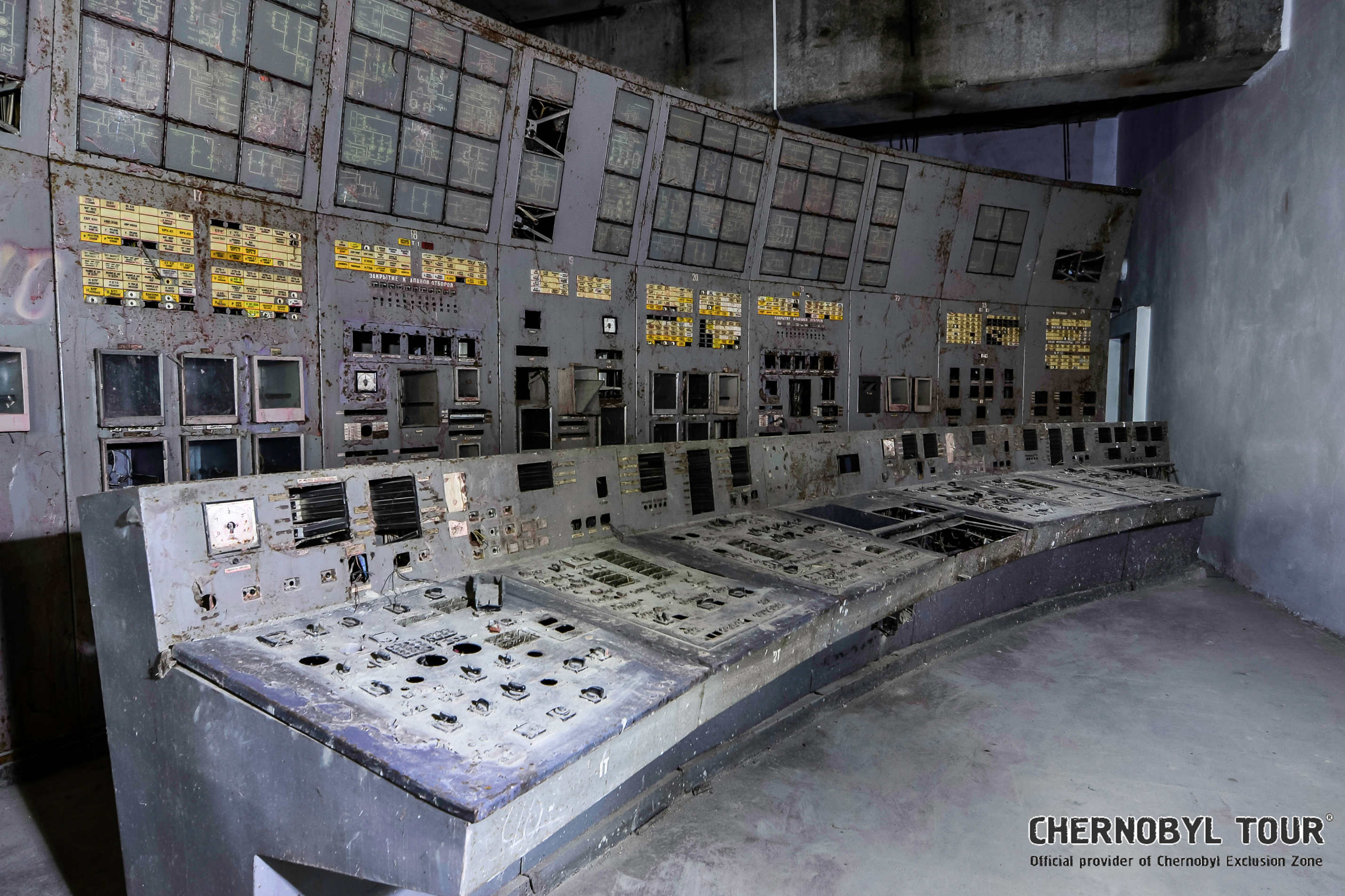
But now those brave enough can venture inside the scene of the catastrophic event for a brief, post-apocalyptic visit as it opens to tourists for the first time ever. Those who enter can only do so through organised visits with official tourist agencies. They will be provided with protective suits, respirators and helmets and can only stay for a few minutes to prevent overexposure to radiation. After leaving, they must undergo two radiology tests. According to the World Nuclear Association, reactor No. 4 still contains about 200 tonnes of highly radioactive material deep within its ruins.

How Chernobyl plans to become more tourist-friendly
Today, Chernobyl remains a ghost town surrounded by a 30km exclusion zone that is still considered too dangerous for human habitation. However, that exclusion zone is not considered too dangerous for short-term visits . The disaster site has seen a huge increase in visitor numbers in recent years as part of a growing global trend of dark tourism. Those numbers were given another boost by the success of HBO's Chernobyl miniseries which aired this year. Indeed, reports indicate that bookings are now up by as much as 40%. The government has been improving facilities in the area such as walking trails, checkpoints and recently approved riverboat tours and in July, it announced 21 new tourist routes.
Tour agencies like SoloEast and Chernobyl Welcome offer day trips to the area and Chernobyl Tour , which was founded by Sergii Mirnyi, a former emergency worker who took part in the post-disaster clean-up, is now offering visits to reactor No. 4.
Explore related stories

Tips & Advice
Jun 4, 2024 • 13 min read
Lonely Planet staffers share some of their favorite US destinations.

Jun 5, 2024 • 17 min read

Jun 4, 2024 • 7 min read

Jun 4, 2024 • 4 min read

Jun 4, 2024 • 6 min read

Jun 4, 2024 • 5 min read

Jun 3, 2024 • 11 min read

Jun 3, 2024 • 6 min read
- GBP £
- CZK Kč
Live | The Chernobyl Power Plant with Room #4
- Pay Per View
- Flexible for your Time Zone
- Live and Interactive with Professional Chernobyl Guide
- English language
LIVE EXPERIENCE
Convenient and real-time from anywhere in the world
We take you through the iconic sites of Chernobyl Power Plant, including control room of reactor #4
GUIDE WITH YOU
The whole online experience is hosted by a professional Chernobyl guide
BEYOND REAL TOUR
Visit places that were not accessible to visit in person
WHAT IS INCLUDED IN YOUR CHERNOBYL ONLINE EXPERIENCE
The chernobyl power plant tour like no other.
- THE BEST OF THE CHERNOBYL POWER PLANT
- PROFESSIONAL GUIDE
- NOT PUBLIC FOOTAGE
- FIRST TIME IN THE HISTORY: CONTROL ROOM #4
- 60+ MINUTES OF INSIDER’S VIEW
- ONLY IN ENGLISH
Become an Insider at the Epicenter of the Largest Nuclear Energy Disaster of All Time
Behind the scenes of the chernobyl power plant.
This is the place that changed the history of mankind, financially ruined the Soviet Union, and made the whole world question nuclear energy. Now you are about to witness the Chernobyl Nuclear Power Plant on your own from a totally different perspective from what you’ve seen in movies or documentaries. A perspective that will shake your values and worldview. You will walk in the footsteps of comrade Anatoly Dyatlov who commanded his colleagues and led the situation to the world’s most (in)famous nuclear blast from the safety of your home screen. How far will you go with your Chernobyl guide?
During the Chernobyl Power Plant Online Experience with ChernobylX, you will go much further than any other Chernobyl tourist nowadays, even to the legendary Control room of reactor #4 where the crew lead by Alexandr Akimov failed the safety test and placed millions of lives around the world at risk.
The Chernobyl Nuclear Power Plant online experience will not just take you around the Chernobyl Nuclear Power Plant bit by bit, but it will also recall the complete story from the very decision to build the largest Nuclear Power Plant in the world, through the secret KGB documents stating which defects the fast construction caused, all the way to the destined night of the disaster. With your guide, you will peek into the premises of the Chernobyl Power Plant, you will walk over the memorial alley dedicated to the direct victims of the accident, you will see how the Power Plant operates today, and you will learn how the future of it will look like.
During this Chernobyl online tour you will become a true insider, as you will see how the Chernobyl Power Plant looks like under cover, including the Control rooms (even the one used the faithful night in the bunker). You will also peek into the circulation pumps under the reactor and, if this is not enough, we are also adding the reactor hall.
The most emotional parts are yet to come, the ones that tell the saddest stories. First, you visit the memorial to Valery Khodemchuk, the circulating pump operator, whose body was never found. The dosimeter we have will start to beep, as the radiation will go higher. The radiation level will increase further as you enter the legendary Control room of reactor number #4 via your online lens. Dusty, empty, and radioactive, with equipment disassembled for the investigation purposes.
Listen to the stories by the living legends of the Chernobyl Power Plant, with a perspective from the same spot from where one of our guides eye-witnessed the explosion in 1986. With a Geiger counter in front of the camera you will approach and learn about the largest moveable object on planet Earth – the newest Chernobyl Safe Confinement (sarcophagus). It is just the beginning for the new future of the whole Chernobyl site. So what will Chernobyl turn into? You will learn straight from your guide as questions from you are always welcomed. The distance will not play any role and you can ask anything or even discuss some of the most unbelievable conspiracies about Chernobyl. Or maybe you just want to chat with your guide about their “regular job”. Let your curiosity run free!
Chernobyl Live: The Chernobyl Power Plant online experience will take you behind the scenes of the Chernobyl Power Plant, together with the powerful stories you will see the Chernobyl disaster from a brand new perspective. The true one. The Chernobyl Power Plant online experience is an online streaming tour using original, uncensored video from the Chernobyl Power Plant with your host – a Chernobyl guide. It is streamed live via a ZOOM room where you will be invited from Kyiv, Ukraine to ensure connection (limited coverage of Chernobyl area and inside Chernobyl Power Plant) and a packed programme. For your time-zone convenience, please check the timezone converter to book the right time for you. For your corporate or educational purposes, a private Chernobyl Power Plant online experience is available upon request from 99 €, please inquire directly at [email protected].
We have been on a mission to CHALLENGE YOUR WORLDVIEW since 2008
Pripyat City Welcome Sign
“The entrance to the city dating its foundation back to 1970 which is the same year as the Chernobyl Nuclear Power Plant was started to be built. Tourists nowadays take pictures here, just like we did on our wedding day.”
New Safe Confinement of Reactor 4 (New Sarcophagus)
“After exactly 30 years, we ensured the safety of Europe by putting this New Safe Confinement above the old sarcophagus. To build the old one in Soviet times took 7 months. The new one was done in 9 years. But it should last another 100.”
Swimming pool Lazurny
“The biggest swimming pool Lazurniy (Azure) was a pride of our city! We use to come here right opened shortly before the accident in 1986, so I had the pride to go swimming there after its reopening for Chernobyl zone workers in 1988. Together with the sauna it was the best relax after whole day patrolling.”
Prometheus Cinema
“There was just only one cinema in our city. I was 23 years old and lived right in front of the cinema called Prometheus - the greek God who gave the fire to the humanity. For the young ones, the cinema was rather a symbol of fire burning in our hearts as we took our girlfriends and wifes here for a cinema night”
Cooling Towers of reactors number 5 and 6
“Two huge cooling towers for reactor 4 and 5 of the Chernobyl Power Plant were under construction when the accident happened. When I came down to the site for the first time, I loved the incredible echo inside”
Command centre Duga
We saw this monstrous radar from our home in Pripyat, we were told it is some kind of antenna. Soviet over-the-horizon Duga Radar in Chernobyl was the third of its kind in the USSR but it was basically commissioned due to numerous flaws.”
Lenin Monument
“Statues of Lenin were everywhere across the Soviet Union and our beloved city Chernobyl wasn’t an exception. Each kid was calling him “Grandpa Lenin”, even my daughter. Today, this is the last statue of Lenin in Ukraine.”
CHERNOBYL POWER PLANT TOUR LIKE NO OTHER
What is included in your chernobyl online tour.
- BEST OF CHERNOBYL POWER PLANT
- ACCESS TO CONTROL ROOM #4 FIRST TIME IN THE HISTORY OF INTERNET
- 60+ MINUTES OF NEW FACTS ON WHAT HAPPENED ON THE FAITHFUL NIGHT OF APRIL 26
- 4 LANGUAGES TO CHOSE FROM ON YOUR PRIVATE ONLINE TOUR
Aditional Tours
Live | chernobyl & babushkas, chernobyl tour, chernobyl 2 day tour, if you waited for a sign, this is it..., this website uses cookies.
Cookies help to improve the services we provide to you. Read information on how we use them and how you can reject cookies by setting your browser.
Functional Cookies Some cookies we place on your browser ensure that the Chernobyl X website delivers you information and services securely and optimally.
Legitimate interest
Advertising cookies We sometimes use tracking pixels that set cookies to assist with delivering online advertising.
You are using an outdated browser. You can update it on this page .
- The Inventory

Chernobyl's Infamous Reactor 4 Control Room Is Now Open to Tourists
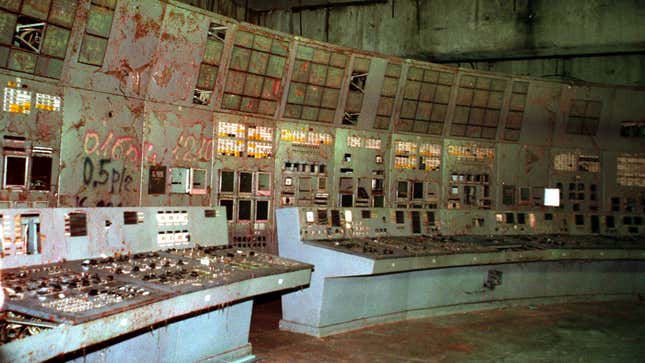
The “highly radioactive” control room at Chernobyl Nuclear Power Plant’s Reactor 4 at the center of the facility’s infamous 1986 catastrophe is open for tourists, so long as they wear a protective suit, helmet, and gloves while inside, CNN reported .
Related Content
Chernobyl tour agencies confirmed to the network that the control room is now open for guided walkthroughs following Ukrainian President Volo dymyr Zelensky’s July decision to proclaim the region an official tourist attraction (and perhaps not coincidentally, a surge of interest following the release of HBO’s wildly popular Chernobyl miniseries). Those who enter the unit must afterward submit to two radiology tests to measure exposure to contaminants.
Chernobyl and the neighboring town of Pripyat the epicenter of a roughly 1,000-square-mile (3,200-kilometer) exclusion zone, though parts of the area have long been visited by tourists and many places that remain officially off-limits are often entered by thrill-seekers . Reactor 4, including the control room, has been off-limits to all but a handful of people; according to Ruptly , radiation in the room is some 40,000 times higher than normal.
As for what to expect, in 2011 the Guardian reported that the room had largely been stripped of its plastic instrumentation switches by “souvenir-hunters among the decommissioning staff,” though some things such as diagrams on the behavior of the reactor and aged wiring remained. (Presumably there is no graphite there.) The seriously damaged unit 4 reactor itself and its original sarcophagus has been covered in a 32,000-ton arch called the New Safe Confinement.
Sergiy Ivanchuk, director of SoloEast tours, told Reuters in June that his bookings for tours had risen 30 percent in May 2019 (when the HBO miniseries was released) compared to years prior, while bookings for the summer months had risen some 40 percent. Tour guide Viktoria Brozhko told Reuters, “Many people come here, they ask a lot of questions about the TV show, about all the events. People are getting more and more curious... During the entire visit to the Chernobyl exclusion zone, you get around two microsieverts, which is equal to the amount of radiation you’d get staying at home for 24 hours.”
The 1986 incident resulted in 28 deaths from acute radiation syndrome and 15 deaths from child thyroid cancer. The full death toll remains the subject of dispute, with most estimates pegging the number of expected long-term cancer cases from the disaster in the tens of thousands .

Chernobyl Control Room Tour
- Tour details

Trip Details

Full-day Private tour & Control room tour
Tour description
- Tour includes excursion around Chernobyl Nuclear power plant with entrance to the control room of the 4th exploded reactor (4 hour excursion) + private exploration of Pripyat ghost town and Duga radar (Russian Woodpecker)
- It'll be just You alone or with the people You know.
- You get the ability to alter the route
and focus on the places You want to see most!
- Please check the Overview below for details -
Trip Overview
Discover chernobyl power plant today, chernobyl tours.
Excursions to the Chernobyl Exclusion Zone boomed several years ago, basically because they were finally facilitated for English-speaking guests. Since then we've come a long way from giving short walking tours around ghost city Pripyat to what is now known as a full-day Chernobyl Private tour . Nowadays, we are able to provide a full-scale private tour with the access to the control room of the 4th exploded reactor and the possibility to alter the route according to your preferences. You will see the atrocious trace of a nuclear disaster and talk to engineers who know Chernobyl Nuclear Power Plant history as the back of their hand.
Tour to Chernobyl from Kiev
Our Chernobyl tour guide picks you up at convenient for you and your team location in Kiev and while going to Chernobyl you will be listening to interesting facts about Pripyat today . Then, after passing quick passport control at the checkpoint you enter the zone and find yourself surrounded by a spooky and thrilling Chernobyl exclusive zone wildlife. During your Pripyat guided tour you will be able to come inside the abandoned buildings, see what remained from a busy city and check the radiation level with a special device - Geiger counter (radiation dosimeter).
Can you visit Chernobyl Power Plant?
The highlight of this tour is a visit to the Chernobyl Nuclear Power Plant where engineers will show you around the power plant, including the renowned control room of 4th exploded reactor, and explain every detail you want to know. You can even ask them about the accuracy in the TV series and figure out why the story is even more tragic than it was depicted. Show more...
The highlight of this tour is a visit to the Chernobyl Nuclear Power Plant where engineers will show you around the power plant, including the renowned control room of 4th exploded reactor, and explain every detail you want to know. You can even ask them about the accuracy in the TV series and figure out why the story is even more tragic than it was depicted. Naturally, by the middle of the day, hunger will kick in, and guess what! The authentic Soviet-Style canteen is open for our guests. If not, we will take care of a restaurant delivery for you. Anything to make you happy. When exiting the Chernobyl reactor you will pass the radiation control that scans the whole body. Your safety is about all! Afterwards, you are free to continue exploring Chernobyl tourist attractions with our tour guide for another hour or two. The distance from Chernobyl to Kiev is approximately 90km and usually doesn't take more than 3 hours.
Chernobyl Tours Safety
The Chernobyl exclusion zone radiation level does not exceed safety standards set for humans. Moreover, you get more exposed to radiation while traveling by plane (the Sun is the biggest source of radiation in our Solar system), so visiting Chernobyl is not really what you should be worried about. Also, we cover your insurance and provide a return transfer, so getting lost is not an option either. If there are still questions you'd like to ask, feel free to contact us and we will guide you through.
How it works
Chernobyl's Control Room Is Now Open to Tourists … for 5 Minutes
The radiation in the room is 40,000 times higher than normal levels.

Tourists can now visit the control room of Chernobyl's Reactor 4, the scene of the world's worst nuclear disaster. But the control room is still highly radioactive, and people are required to wear protective gear when inside, according to recent news reports.
Ukranian President Volodymyr Zelensky declared Chernobyl an official tourist attraction in June at the inauguration of a gigantic dome built to contain radioactive material. But Chernobyl has been a tourist destination for far longer — parts of it having been open to the public for nearly a decade. In May, bookings to Chernobyl increased by about 30% following the release of the popular HBO series of the same name, according to a previous Live Science report .
But Reactor 4 had remained closed off to most of the public, save for a few researchers and cleanup workers. Now, Chernobyl tour companies have confirmed that the control room is open to the brave souls who wish to be closer to the scene of the disaster, according to CNN .
The control room, which was highly damaged from the explosion, was where the reactor was operated from and where many of the decisions the day the reactor exploded, were made. It sits under the new containment arch but outside of the original sarcophagus that contained the radiation of the reactor itself, according to the Telegraph .
Related: 5 Weird Things You Didn't Know About Chernobyl
The radiation in the room is 40,000 times higher than normal levels, according to Ruptly , a German news agency. Anyone who wishes to visit the site must wear a protective suit, a helmet and a mask, and limit their visit to 5 minutes. Afterward, visitors are required to undergo two radiology tests to measure the amount of radiation they were exposed to, according to CNN.
That's typical of most tours in Chernobyl; people must go through radiation checkpoints at the beginning, middle and end of one-day tours, according to a previous Live Science report . Tourists are not permitted to wander on their own; they must stay with the tours because of ongoing radiation concerns.
Sign up for the Live Science daily newsletter now
Get the world’s most fascinating discoveries delivered straight to your inbox.
Other parts of Chernobyl remain off-limits, including the "machine cemetery" in the Rossokha village, which is where the contaminated machines used during the Chernobyl cleanup were dumped, according to CNN. Exposure to large amounts of radiation can cause tissue damage and acute sickness, as well as increase the risk of cancer. However, Ukranian officials have deemed the areas that are open to tourists to be safe, as long as they follow the rules.
- 10 Times HBO's 'Chernobyl' Got the Science Wrong
- Images: Chernobyl, Frozen in Time
- 5 Everyday Things That Are Radioactive
Originally published on Live Science .

Yasemin is a staff writer at Live Science, covering health, neuroscience and biology. Her work has appeared in Scientific American, Science and the San Jose Mercury News. She has a bachelor's degree in biomedical engineering from the University of Connecticut and a graduate certificate in science communication from the University of California, Santa Cruz.
Cutting pollution from the shipping industry accidentally increased global warming, study suggests
The 165-year reign of oil is coming to an end. But will we ever be able to live without it?
Japan loses contact with Akatsuki, humanity's only active Venus probe
Most Popular
- 2 James Webb telescope sees 'birth' of 3 of the universe's earliest galaxies in world-1st observations
- 3 Space photo of the week: NASA sees a 'Platypus' move on Jupiter's moon Europa
- 4 Things are finally looking up for the Voyager 1 interstellar spacecraft
- 5 Mutant blue-eyed cicadas discovered outside Chicago during rare double brood event
- 2 Wreck of WWII 'Hit 'Em Harder' submarine, which sank with 79 crew on board, discovered in South China Sea
- 3 3,500-year-old rock art of wild sheep and double-humped camels revealed in Kazakhstan
- 4 Cutting pollution from the shipping industry accidentally increased global warming, study suggests
- 5 Elusive 'octopus squid' with world's largest biological lights attacks camera in striking new video
Tours to the Chernobyl nuclear power plant
It’s been 34 years since the Chernobyl reactor #4 exploded and caused the biggest nuclear fallout in humans history. Being covered with a large temporary concrete sarcophagus, and later with a proper giant protective steel dome, the RBMK reactor and its premises around were untouched and unseen by tourists. Things changed in the summer of 2019. By decision of the Ukrainian government, Chernobyl, which used to be seen as a negative part of Ukrainian history, now has a chance for a new life.
And before you make your decision to step on the intriguing and previously forbidden land, we would like to share some interesting facts about the power plant, its history and construction, radiation and its impact on human bodies and, of course, safety concerns.
A small history flashback
The plant’s first name was Central Ukrainian Nuclear Power Plant. It was later renamed to Vladimir Lenin power plant officially, but was often and still is referred to as Chernobyl Nuclear Power Plant. It consisted of four reactors by the time of the incident, and another 2 were under construction; it was one the best technological achievements of the USSR, powering millions.
The Soviet Union was famous for its desire for superiority around the globe. When it came to constructing power sources, it was decided to create the biggest nuclear station that will produce 12 mWt of energy to provide electricity to not only Soviet countries but also to the “rich West” who was always in need. It was a genius and an ambitious plan to conquer the world.
It probably would have been a success if, in 1986 the accident hadn’t happened. That’s partially the reason why the truth was hidden from the world for such a long time. The explosion wiped out this dream and had many effects on the USSR and the world.
Former USSR president Gorbachev claimed that one of the main victims of the disaster was the Soviet Union itself. The disaster shook confidence in the Soviet system as well as the world’s perception of the USSR’s capability. In many ways, this location is where, arguably, the soviet empire began to crumble.
Chernobyl reactor 4 control room (UCR 4)
We do not want to spoil for you what exactly you’ll see or feel once you’re inside the room. Today UCR 4 is the premise with partially dismantled Unit control panel equipment, but this makes it look even creepier. And yes, the button AZ-5 is still there and you can try to press it if you dare.
This control room, number 4, is only available for visits in the “Basic+” option. There is also reactor number 3. It looks absolutely the same as reactor 4, and has the same control panels, buttons, etc. because they are both part of the same building. Control room of reactor number 3 is available on both “Basic” and “Basic+” tours. Please check our itineraries for details.
What’s special about Chernobyl power plant tour ?
Experiencing the inside of the power plant is essential if you are eager to know the entire story of Chernobyl. There are so many reasons to come to the power plant:
- Visit first-hand the location of a historical event – this is the chance for an inside look of the power plant which the infamous disaster occurred at.
- See a Soviet nuclear power plant with a unique RBMK reactor – for those of you who are interested in nuclear energy, its history and or its physics, this place is a must-see.
- Learn about the history, science and technical side of the disaster from an expert.
- Enter the underground bunker where the authorities had the first emergency meeting regarding the accident.
- Stand in the reactor hall, a stone’s throw from the exploded reactor number 4.
- Take photos of you and your friends in the control room.
- See (or even press) the AZ-5 button and experience how it feels.
Here you have the chance to take a look at the very unique and rare RBMK reactors which are now only used only in 3 places in Russia. Initially modified after the disaster, many of them were phased out. The RBMK type reactor is the only kind of reactors that has a positive void coefficient, which was one of the factors that led to the accident. It was a very common reactor in the USSR and even post-soviet countries.
Interestingly, in the HBO series the control room scenes were filmed in a decommissioned RBMK power plant in Lithuania (named Ignalina), closed down in 2004 as part of an agreement for them to join the EU. Ignalina was chosen for filming because in the USSR, uniformity in style and design was demanded in almost all areas across the empire, hence it is almost identical to the Chornobyl plant. You can come and see for yourself, feel like you are in the TV series, compare the differences or feel like you’ve gone back in time.
You will have a great opportunity to learn a lot about science, history and anything else you want to know. The guide who takes you on this tour is an expert and will inform you about the finer details of the power plant, how and why the disaster took place that fateful night in 1986.
Safety concerns
Before we start to talk about radiation inside the power plant, let us tell you that radiation is everywhere around you: phones, microwaves, even just the air itself has some kind and some amount of radiation. The question is in its quantity – some levels are not harmful for people, while some actually are. 6-7 sieverts per hour considered to be a lethal dose. 1 sievert is equal to 1 000 000 microsieverts. The amount of radiation visitors are exposed to in a short time is not harmful and equal to about 4 microsieverts (μSv). It’s well under the 100-microsievert total dose the safety instructions allow visitors.
Radioactive dust is the main hazard you can face during the visit, but you’ll be fine as long as you obey the rules. Each visitor is provided with a full body costume, respirator, gloves, helmet and a dosimeter. After your visit there will be 2 radiation control frames of different sensitivity that will ensure you didn’t take any radioactive particles with you.
Any other questions? Maybe you can find your answer here:
Depending on the type of tour you choose you are able to see the administrative building, a bunker where the authorities gathered to make a decision about next steps, the reactor hall, golden corridor, main circulation pumps, a unique electronic computing machine called SKALA, one of the control rooms or several of them. You can check a full itinerary above.
The tour inside the power plant takes approximately 3 to 5 hours from the starting point. Getting there and back from Kyiv will take you another 3-4 hours depending on the traffic on that day. Bear in mind that you will need to cross the border of the Exclusive zone. That is why Chernobyl NPP tours are available as an option on private tours to the Chornobyl zone.
Yes, It is possible to visit the town of Pripyat in the same tour, as you need to get special permits to cross the border of Chornobyl zone. Our private tours are tailored trips up to your needs.
Near 2000 people are still working on the plant. Mostly they are working on the decommissioning of the power plant. It’s a long process, and it takes time. Plus, there are tons of radioactive debris inside the destroyed reactor that need to be extracted, deactivated and transferred to the special storage.
Just after the accident, all units of Chornobyl Nuclear Power Plant were shut down. But later on, decontaminated and restarted. The decision on the pre-schedule shutdown of all units of ChNPP was caused because of Ukraine’s obligations towards the world community stipulated in the Memorandum of Understanding between the Government of Ukraine and Governments of the G7 countries in order to receive their help in funding the building of the New Safe Confinement. Chornobyl NPP officially stopped the generation of electricity on 15th of December, 2000. At 13:17.
It is difficult to name one reason for the accident, as there were a variety of human factors involved. First, in the construction of the reactor, errors were present and hidden from the staff. Secondly, the reactor had been operating at half-power for a long time, facilitating the poisoning of the reactor. Finally, the decision by the operators is also a factor (famously, this was the key or only factor according to soviet officials, in order to downplay the structural and quality-based problems).
These combined in a fatal way, this is just a summary, but here you can read in more detail. The staff wanted to proceed with the test ordered to them requiring to lower the power among other things, none of which effectively communicated. Finally, when they pressed the AZ-5 button to stop the power, due to inadequate quality and errors in construction, the power went up and led to the explosion.
To summarize, if you come on this tour you’’ll be able to see Chernobyl Nuclear Power Plant from the inside and the control room, (On basic+ tour also the Chernobyl reactor #4 control room ), see an RBMK reactor which is very rare and just like the one that exploded, see the location of an historical event and come away with a lot of new knowledge and memories that will stay with you forever.
You Can Now Go Inside Chernobyl’s Reactor 4 Control Room
By ellen gutoskey | oct 23, 2023, 6:17 am edt.
The eerie interior of Chernobyl’s Reactor 4 control room, the site of the devastating nuclear explosion in 1986, is now officially open to tourists—as long as they’re willing to don full hazmat suits before entering and undergo two radiology tests upon exiting.
Gizmodo reports that the structure, which emits 40,000 times more radiation than any natural environment, is encased in what's called the New Safe Confinement, a 32,000-ton structure that seals the space off from its surroundings. All things considered, it seems like a jolly jaunt to these ruins might be ill-advised—but radiology tests are par for the course when it comes to visiting the exclusion zone, and even tour guides have said that they don’t usually reach dangerous levels of radiation on an annual basis.
Though souvenir opportunists have made off with most of the plastic switches on the machinery, the control room still contains original diagrams and wiring; and, according to Ruptly, it’s also been covered with an adhesive substance that prevents dust from forming.
The newly public attraction is part of a concerted effort by the Ukrainian government to rebrand what has historically been considered an internationally shameful chapter of the country's past.
“We must give this territory of Chernobyl a new life,” Ukraine's president Volodymyr Zelensky said in July. “Chernobyl is a unique place on the planet where nature revives after a global man-made disaster, where there is a real 'ghost town.' We have to show this place to the world: scientists, ecologists, historians, tourists."
It’s also an attempt to capitalize upon the tourism boom born from HBO’s wildly successful miniseries Chernobyl , which prompted a 35 percent spike in travel to the exclusion zone earlier this year. Zelensky’s administration, in addition to declaring the zone an official tourist destination, has worked to renovate paths, establish safe entry points and guidelines for visitors, and abolish the photo ban.
Prefer to enjoy Chernobyl’s chilling atmosphere without all the radioactivity? Check out these creepy photos from the comfort of your own couch.
[h/t Gizmodo ]
Chernobyl’s Control Room Is Open for Tourists
Who’s up for a radioactive selfie?
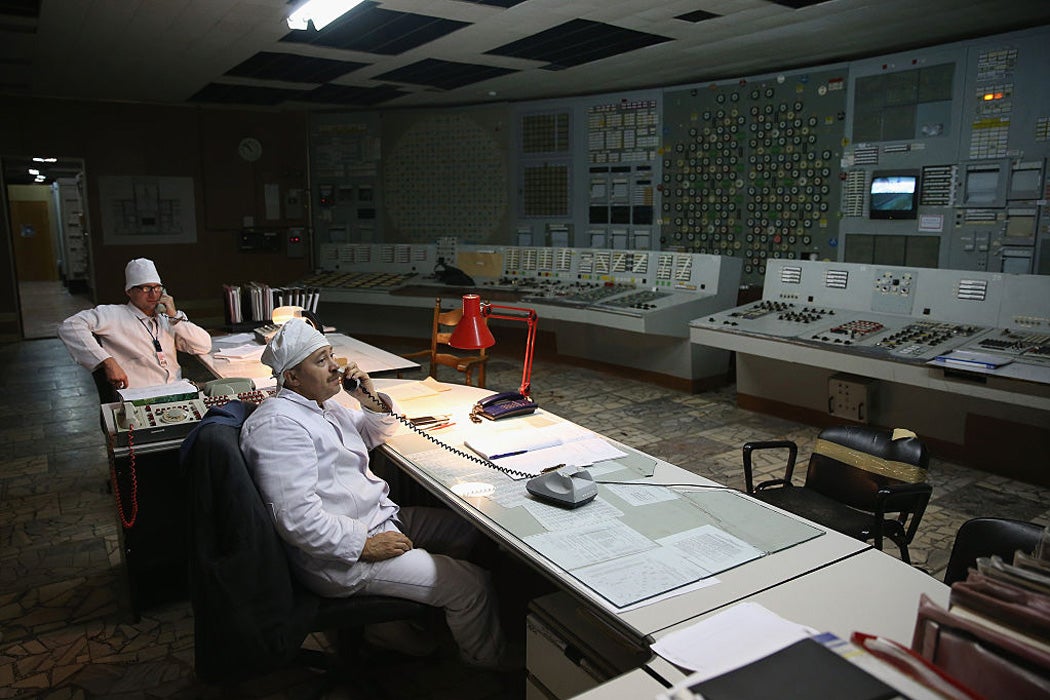
Good news for today’s morbid tourist on the go: Chernobyl’s reactor 4 control room, where technicians tried and ultimately failed to prevent the worst nuclear disaster in history, is now open for tourists . Visitors must wear protective clothing, limit their stay to 5 minutes, and undergo radiation checks. But for those willing to risk it, surely a once-in-a-lifetime experience awaits. But is it worth it? What does radiation exposure do to the body?

Humans are exposed to low-dose radiation from a variety of sources, ranging from medical scans to occupational exposure. Given that high levels of radiation are associated with various cancers, David Brenner and colleagues set out, in a PNAS article, to determine just how much low-dose radiation noticeably raises cancer risk .
First off, how much radiation would a participant in the control room tour actually experience? Brenner puts ordinary background levels at 3 milliSieverts (mS) per year. According to Livescience, the radiation in the control room is 40,000 times normal background levels. Some quick math means that a control room visitor will be exposed to around 1.14 mS in 5 minutes, excluding any benefit from protective gear. For comparison, residents of Ukraine in the vicinity of the blast have an exposure of 14 mS over a 70-year period. Astronauts on the ISS receive a comparatively huge 170 mS per year. To be fair, that is much less per year than in the Chernobyl control room.
So, in the grand scheme of things, one control room tour is not a ton of radiation, much less than what’s caused by most medical scans. Brenner notes that calculating cancer risk is difficult, since most studies examining radiation and cancer risk focus on much higher doses. At smaller doses, an enormous sample size is needed to tease out cancers caused by the radiation versus cancers that would have happened anyway. Brenner proposes to solve the problem by extrapolating backwards from higher dose studies to calculate a risk for lower doses. In humans, there is only solid evidence for increased cancer risk at radiation doses around 10-50 mS (or greater).
Weekly Newsletter
Get your fix of JSTOR Daily’s best stories in your inbox each Thursday.
Privacy Policy Contact Us You may unsubscribe at any time by clicking on the provided link on any marketing message.
Now, before you book your ticket to Chernobyl, you should know that Brenner notes that acute exposure over a short term is more risky than long-term, occupational exposure. Since cancer operates on individual cells, less radiation means fewer cells receive dangerous exposure, so the risk of cancer should decrease in proportion to the dose of radiation. While Brenner doesn’t present a number, the analysis suggests that the cancer risk is pretty low. He also suggests that there is some evidence that, as radiation decreases, the risk decreases even more, but concludes on the cheery note that since cancer can begin with just one cell, he might end up incorrectly estimating the risk. In other words, while it’s probably low, nobody knows for sure. Enjoy that selfie!

JSTOR is a digital library for scholars, researchers, and students. JSTOR Daily readers can access the original research behind our articles for free on JSTOR.
Get Our Newsletter
More stories.

How the Universe Forges Stars from Cosmic Clouds

The Vital Near-Magic of Fire-Eating Fungi
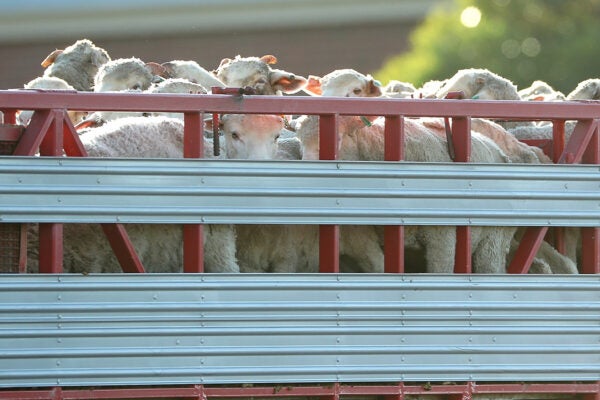
The Long History of Live Animal Export

Haunted Soldiers in Mesopotamia
Recent posts.
- Lessons for American Zionism from the “Free Ireland” Cause
- Rickshaw Men, Optical Computing, and Telegraph Flirting
- Who Took the Cocaine Out of Coca-Cola?
- The Great Dissenter’s Complications
- The Joy of Burglary
Support JSTOR Daily
Sign up for our weekly newsletter.
Reactor No 4

Top ways to experience Reactor No 4 and nearby attractions

Most Recent: Reviews ordered by most recent publish date in descending order.
Detailed Reviews: Reviews ordered by recency and descriptiveness of user-identified themes such as wait time, length of visit, general tips, and location information.

Also popular with travelers

Reactor No 4 - All You Need to Know BEFORE You Go (2024)
Visiting Chernobyl: All You Need To Know

*Our Visiting Chernobyl post may contain affiliate links, if you click the link and purchase an item through this you won’t pay a penny more, but we get a small commission which helps keep this website up and running, thank you!*
All You Need To Know About Visiting Chernobyl
Tourism to the Chernobyl exclusion zone has been on the rise ever since the first images of skeletal buildings and eerie, deserted classrooms appeared on the internet. In recent years Dark Tourism sites , like Chernobyl, have become ever more popular, often coming with questions regarding safety and the ethics of visiting such locations. With this in mind, we’ve created a detailed guide, answering some of the most popular questions, explaining our experience and reviewing a top tour company.
What happened in Chernobyl?
On April 26th 1986, operators at the Chernobyl Nuclear Power Plant were performing a routine safety test in Reactor 4. When the power reached dangerously low levels, operators violated safety precautions and removed the control rods. The test continued with emergency and safety systems turned off. At 1:23AM a power surge occurred, the emergency button was pressed but the control rods jammed. A series of explosions followed which ejected radioactive particles from the reactor core into the night sky. Lethal fumes rose up forming a radioactive cloud above the now destroyed nuclear reactor. The cloud deposited deadly radioactive particles over the surrounding area, reaching many parts of Europe.
A more detailed account of the devastating events can be found here along with an informative article from Live Science explaining the aftermath and health impacts on those nearby.

Visiting Chernobyl: FAQ's
Where is chernobyl.
- Can you visit Chernobyl?
- Is it safe to visit Chernobyl?
- Is it worth visiting Chernobyl?
- Can You Visit Chernobyl Without A Guide ?
- Which is the Best Chernobyl Tour ?
- Chernobyl 1 Day Tour Itinerary
- How much does it cost to visit Chernobyl?
- When is the best time to visit Chernobyl?
- What’s the weather like in Chernobyl?
- What to wear to Chernobyl?
Visiting Chernobyl: Zone Rules
- What’s Chernobyl like today?
- Dogs of Chernobyl
- How accurate is Chernobyl HBO?
Facts and Figures
Chernobyl is in Ukraine, approximately 80 miles north of the capital Kyiv and 12 miles south of the Belarus border. Public access is limited in the 30km Exclusion Zone which extends from the Chernobyl Power Plant. The zone is controlled by the Ukrainian authorities and access gained through a series of strict checkpoints. The exclusion zone is still one of the most radioactive places on Earth.
The map below shows the location of the Chernobyl Power Plant and the extent of the exclusion zone.

Can You Visit Chernobyl?
Chernobyl opened to visitors in 2011 when it was officially declared ‘safe’. Since HBO’s Chernobyl miniseries , tourism to the disaster site has significantly increased with around 150,000 people visiting in 2019. Ukrainian President Volodymyr Zelensky announced in mid 2019 that Chernobyl would become an official tourist attraction .
The Independent reported plans to improve phone signal and infrastructure in the zone as well the creation of a ‘Green Corridor’ to offer official and safe entry. In fact, the authorities have recently launched 21 new tourist routes as part of the new improvement plans. They also opened the infamous Reactor 4 Control Room which still reads at over 40,000 times normal radiation levels! As a result, visitors are limited to a 5 minute visit and must wear full protective clothing.

Is it Safe to Visit Chernobyl?
Provided you enter the Chernobyl Exclusion zone with a qualified tour guide, it is safe to visit . If you follow the rules, you will only be exposed to levels similar to that of a long haul flight . However, there are still some highly radioactive hotspots making it crucial to listen to your guide.
Whilst in the exclusion zone you will pass through several radiation check points which will put your mind at ease. Although we have read some theories that these checkpoints don’t actually work!
Live Science have a helpful and informative article explaining more about the levels you’re exposed to whilst in the zone.
Fact: The Ukrainian Army use the exclusion zone once a year to ‘practice’. As a result some buildings are full of bullet holes and have been heavily damaged.

Is it Worth Visiting Chernobyl?
Visiting Chernobyl is important . It’s a surreal experience which provides you with a unique perspective of the scale and impact of the disaster. By visiting you are playing your part in preserving the memories and passing on knowledge of the horrific event. It was an event which changed history and is a stark reminder of the dangers mankind poses to the natural environment and to itself.

Can You Visit Chernobyl Without A Guide?
Visiting Chernobyl without a guide is illegal and is also extremely dangerous, however some do ‘sneak’ into the zone. There are even companies who run covert multi-day tours which see tourists sleeping in derelict apartment blocks. For thrill seekers, this may sound exciting, however with so many unstable structures and unseen risks, it’s extremely dangerous. Those who enter the zone illegally are known as ‘stalkers’ (originating from the 1972 Russian science fiction novel ‘Roadside Picnic’).
The Calvert journal has an interesting article on Chernobyl’s secretive ‘stalker’ subculture , detailing risks including food and water consumption in the zone.
Fact: Window frames and valuables were stolen and buildings stripped of cabling by looters in the early 1990s. It’s estimated that 6 million tonnes of radioactive metal was looted and recycled into everyday items.

Which is the Best Chernobyl Tour?
After some careful consideration and visiting many tour websites claiming to be ‘the best’ we settled on ChernobylWel.come . If like us, it’s important that you use a responsible tour company and that groups are small, ChernobylWel.come is ideal. They support several worthwhile initiatives ; each tripadvisor review plants a tree in the zone to aid with nature’s recovery. They also support the Chernobyl Babushkas, providing them with medicine and groceries, and regularly support the children’s cancer charity, Dobry Anjel. These important initiatives combined with great reviews and an alluring trip itinerary convinced us to book their 1 Day Tour from Kyiv.
Visiting Chernobyl: Tour Trailer
Our guide, Helga, was extremely knowledgeable about the zone and the accident. She had previously interviewed former Chernobyl residents and so was able to share the information she learned from them. As a photographer, she also identified some interesting locations to ensure we went away with memorable images from our tour.
Top Tip: Use code: GLOBETROTTERS at checkout to get some free gifts on any tour you book with them!
If we were to visit Chernobyl again...
We would book the 2 day tour option if we were visiting Chernobyl again, there is just so much to see! We did visit a lot of places but remain intrigued to see more of the less frequented locations. ChernobylWel.come also run private tours if you want to visit specific sights or would just rather not be in a group.
Overall, we thoroughly enjoyed our experience with ChernobylWel.come . It was factual, interesting and responsible. We learnt a lot about the disaster and now understand much more about exactly what happened on 26th April 1986.

Visiting Chernobyl: 1 Day Tour Itinerary
Different companies have different itineraries so if you’re interested in a specific sight, ensure the tour you choose stops there! Alternatively, you can book a private tour. Our 1 Day Tour from Kyiv with ChernobylWel.come in January 2020 followed the below itinerary.
Top Tip: The meeting point is outside Kyiv’s main train station which is massive and confusing to navigate (unless you speak Ukrainian). Therefore it’s worth doing a recce beforehand to ensure you get there on time. We went the night before and got lost A LOT! Puzata Hata (the meeting point near the station) is also a great self service restaurant where you can have dinner the night before or after the tour.
Finding the Meeting Point
The tour began with an early 7:30AM start in Kyiv, we met the bus outside the Puzata Hata Restaurant, near the train station. We’d heard that the meeting point could be difficult to find so had done a recce the night before. If you’re really late, they’ll leave without you, which nearly happened to some members of our tour. They hadn’t planned ahead, left it to maps at the last minute and got lost. It was very frustrating for everyone else who had been on time, so don’t be late.
Top Tip: There’s a McDonald’s around the corner from the meeting point. If you fancy a treat and you’re an early riser, what better way to start the day than by demolishing a greasy Bacon & Egg McMuffin! Puzata Hata also serve breakfast but we ate there the night before so treated ourselves to McDonald’s…
Journey from Kyiv to Chernobyl
The bus journey from Kyiv to the exclusion zone takes 2 hours. This sounds like a long journey but it passed quickly. ChernobylWel.come show a documentary on the bus and gave everyone a ‘newspaper’ to read with articles from the time of the accident.
Top Tip: There is a brief toilet and refreshment stop before entering the zone. If you forgot to bring snacks it’s worth picking up a few there. Once in the zone there’s nowhere to buy food and lunch is usually between 1PM-3PM.

First Checkpoint
When you arrive at the first checkpoint passports and documents are checked by the Ukrainian authorities. There’s a small gift shop but the tour also stops here on the return journey so no need to rush to buy souvenirs yet! Once through this checkpoint, you’ve officially entered the exclusion zone. Fascination and intrigue begins to build as you spot mysterious derelict buildings and discarded belongings appearing in the forest as you drive to the next checkpoint.
Top Tip: Use the bathroom whenever there’s one available! The only toilets are at lunch time or at the checkpoints when you enter/exit the zone. A large portion of the day before lunch is spent walking around Pripyat where there are no facilities. There’s definitely no nature wees allowed!
After passing through all the checkpoints it’s time for the first stop! Below we’ve listed the stops we made in chronological order.
1. Chernobyl's Red Forest
Chernobyl’s Red Forest is one of the most radioactive areas on earth. It’s located only 500 meters from the power plant and absorbed high levels of radiation from the initial explosion. Many trees died and turned orange (hence the name) and much of the forest is still out of bounds. For that reason, we drove straight through the forest, glued to our geiger counters as they beeped like crazy!

2. Pripyat Town Sign
Before entering the ghost town, every tour stops at the iconic Pripyat Town Sign. Unfortunately this historic monument is often vandalised and is regularly repainted. On the opposite side of the road to the sign is a radioactive hotspot, “don’t put anything on the ground there ” shouts our tour guide *Eve drops mitten* … From this stop we were also able to view the Red Forest at a safe distance.

3. Pripyat Fairground
All Chernobyl visitors are keen to see the ferris wheel, made famous by games like Call of Duty and Stalker. The Pripyat Fairground was due to open just a week after the nuclear disaster. However, it’s speculated that it did momentarily open the day after the disaster to distract local residents from what was unfurling only a short distance away. After Pripyat was evacuated, the fairground was used to land helicopters during the immediate aftermath.
Pripyat was built to house workers at the nearby Chernobyl Nuclear Power Plant in 1970. At the time of the accident, it had a population of around 50,000 people. Comprising 160 apartment blocks, 20 schools, a hospital, 27 cafes, shopping centres, 3 swimming pools, 2 stadiums and 35 playgrounds, it’s no wonder tours spend several hours in the town. Pripyat is the most visited town in the exclusion zone with hundreds of tourists passing through the abandoned remains each day.
By visiting Pripyat towards the start of our tour, we avoided other groups which would’ve disturbed the eerily quiet atmosphere. We stopped at sights like; Central Square, the Grocery Store , Rainbow Shopping Centre , Energetic Palace of Culture , Pripyat City Council , a local Art Gallery and Prometheus Cinema.

Fact: The average age of Pripyat’s residents before the accident was 26 meaning there were many young couples starting families.
5. Pripyat Hospital 126
The Pripyat Hospital basement is one of the scariest and most dangerous places in the zone . On the night of the accident, first responders were rushed here for treatment. Unbeknown to them and the medical staff, they were highly contaminated. As soon as Doctors discovered this, the firefighter’s clothing was taken to the basement, where it has remained ever since. Sadly illegal stalkers in the zone have brought remnants of the clothing up from the basement. These tiny scraps of cloth litter the hallways and as a result it’s no longer safe to enter the building. Our guide identified a tiny piece of cloth on a window sill, it looked like a leaf and could’ve easily been missed. Edging our geiger counter slowly and carefully towards the fabric, frantic beeping began which resulted in the highest reading we’d see all day!

6. Pripyat Riverport and Cafe
Families gathered along the riverbank to enjoy picnics and pleasure cruises in the summer and ice skating in the winter. Not far from the jetty is the wreck of a boat, half sunken into the radioactive lake. The cafe was known as ‘The Dish’ by local residents and was a popular teenage hangout. It once had huge colourful stained glass windows contrasting the uniform soviet architecture. Around the back of the cafe are several old soviet soda machines. These often had one glass attached by a chain, which would be rinsed and filled, much better than plastic cups!
7. Chernobyl Power Plant and Memorial
Everyone visiting Chernobyl will stop by the famous sarcophagus shielding the remains of reactor 4 from the outside world. Unsurprisingly, the radiation levels within the dome are the highest with the zone. A BBC article documents the new dome as bigger than Wembley stadium and taller than the statue of liberty, it took two decades to build. The final stop before lunch is the Chernobyl Power Plant Memorial which honours those who died in the initial aftermath of the accident, many of whom were first responders.
Top Tip: If actually going inside the power plant interests you, Chernobylwel.come do a 2 day Chernobyl Power Plant and Pripyat tour, as well as a Chernobyl Reactor 4 Control Room Tour.
8. Chernobyl Plant Canteen
After passing through a radiation checkpoint it’s time to enjoy a traditional Ukrainian lunch. Thankfully all the food served in the canteen is grown outside of the exclusion zone! We couldn’t tell you what exactly was on the menu (you got what you were given) but it was delicious and very filling!

Top Tip: Remember to inform your guide of any dietary requirements ahead of the tour so they can accommodate you.
9. Duga Radar System
Hidden amongst the dense woodland in the Chernobyl exclusion zone is one of the Soviet’s best kept secrets. A bus stop labelled ‘Kids Camp’ marks the secret access road to Duga Radar station. Towering 150 metres into the sky, it was part of the Soviet Union’s early missile detection system. Although some conspiracy theorists believe it was linked to mind control or weather experiments.
Fun Fact: Duga was nicknamed the ‘Russian Woodpecker’ due to the repetitive tapping noises its broadcasts made.

10. Bridge of Death
On April 26th 1986, Pripyat residents gathered on the nearby railway bridge to observe the bright flames light up the night sky in the aftermath of reactor 4’s explosion. HBO’s Chernobyl depicts radioactive dust landing on children playing and residents on the bridge, later stating that all those on the bridge that night died. However, there’s varied reports on this and it’s hard to decipher the facts from the fiction regarding the ‘ Bridge of Death ‘. It has been reported that some locals did visit the bridge but no one knows if they survived or if they developed any long term health issues that night. In fact, many Pripyat residents slept through the explosion and plant workers didn’t find out about the incident until they arrived at the plant later that morning.
11. Chernobyl Town
The town of Chernobyl is located 15 km south of the Nuclear Power Plant. It was much smaller than Pripyat, with only 14,000 residents. Remarkably, Chernobyl is still inhabited by around 1000 zone workers today. There are two stores, a post office and a hotel. Those living in the town can stay a maximum of 15 days before they are required to leave for 15 days. The tour stops by the Monument of the Third Angel and a path lined with village signs , each representing a lost village, abandoned in the exclusion zone after the disaster.
12. Chernobyl Welcome Sign
The last stop on our 1 Day tour was the Chernobyl welcome sign. It’s a poignant stop to make and a sad reminder of the tragic events that took so many lives.

How Much Does it Cost to Visit Chernobyl?
Visiting Chernobyl on the 1 Day Tour from Kyiv costs £109 pp (prices as per 2020) with Chernobylwel.come
This includes:
- Return transport between Kyiv and Chernobyl
- Free Wifi on an air conditioned bus throughout the tour (upload pictures to social media instantly!)
- Small groups (small mini bus, no larger than 18 people)
- A free ‘newspaper ‘ to read on the journey
- A TV documentary about the disaster on the way
- Several geiger counters shared within the group (we had 4 or 5 between 15)
- Free individual dosimeter to be worn throughout your time in the exclusion zone
- Photos before the accident shown during the tour.
- All legal documentation to enter the zone
- Traditional Ukrainian lunch at the Chernobyl power plant workers cafe
- Free gifts at the end of the tour
- Free ticket to the Chernobyl Museum in Kyiv
Costs £269 pp , (prices as per 2020) which includes all of the above PLUS :
- Overnight hotel accommodation in the zone
- Traditional Ukrainian Breakfast, Lunch and Dinner
- Opportunity to meet the Chernobyl Babushkas
- Opportunity to see 3 times more sights in the zone than the 1 Day tour

When is the Best Time to Visit Chernobyl?
There isn’t necessarily a ‘best’ time to visit Chernobyl, but maybe a best time to suit you.
If safety is a concern then winter is deemed the safest time to visit. It’s thought that the snow and freezing temperatures provide a blanket over the radioactive particles in the ground. As a result, levels of radiation in winter are generally much lower. Mist, snow and a barren forest make for eerily creepy photos of abandoned buildings standing out in the white forest. We visited in January 2020, it was extremely cold reaching lows of -10°C whilst we were in the zone, we even saw a few snowflakes! The icy ground and chill in the air were a constant reminder of the tragedy and made for a really memorable experience. Visiting on a bright summer’s day would be a very different experience.
There is no snow at this point nor have the trees grown any leaves which means buildings are still visible through dense forest and overgrowth. However, spring doesn’t last long in the zone and is hard to pinpoint exactly as it can change annually. So if spring is when you want to visit Chernobyl, be sure to research so you don’t miss it!
The benefit of visiting in summer is the longer hours of daylight. This is particularly beneficial for those staying overnight in the zone, meaning you may be able to make more stops before or after dinner. It’s also much warmer, averaging around 25°C mid season. The dense greenery disguises many buildings, particularly in Pripyat, but might be ideal for those wanting to ‘discover’ buildings hiding amongst the overgrowth.
Autumn is the most colourful and some say most beautiful time to visit Chernobyl. With leaves beginning to fall from trees, the ground is scattered with red and oranges hues, also allowing visitors to see buildings hidden in the forest, no longer tucked behind a wall of greenery.
Weather in Chernobyl
Weather in the exclusion zone can range from below -10°C in winter to over 30°C in summer. The question above ‘What’s the best time to visit Chernobyl?’ describes each season in more detail. Accuweather give you the historical average from any specific date as well as previous temperatures. Below is a current weather forecast.
Current Weather Forecast

What to Wear to Chernobyl?
Your wardrobe choice will largely depend on the time of year you’re visiting Chernobyl. The most important things to wear at any time of year are sturdy shoes ( you will be walking A LOT! ), long sleeved tops and long trousers (these are to keep you protected from any radioactive particles in the zone). Tours often walk through overgrown and wooden areas which may mean you brush against trees and other organic material.
Temperatures range from -10°C to 30°C throughout the year, check the weather forecast before your visit to ensure you pack the best clothing and maybe even an umbrella!
In winter we recommend LOTS of layers, if you bring too many you can always strip and leave them on the bus. Thermal or thick socks, a hat, gloves and warm jacket are a must.
Visiting Chernobyl involves a lot of walking and exploring outside so it’s important to stay safe in the sun. We recommend taking sunglasses and a sunhat as well as applying suncream regularly. Unfortunately shorts are not permitted.

When entering the Chernobyl exclusion zone it’s important to be responsible , you’re effectively roaming an outdoor museum. It’s a piece of history and it’s important to preserve the site as much as possible. Listen carefully, stay close to your guide and follow any rules they put in place.
Chernobyl Exclusion Zone Rules:
- It is prohibited to put anything on the ground , that includes tripods, kneeling to take that epic instashot or just popping your bag on the ground whilst you get something out.
- You must not touch any vegetation or structures.
- To use a drone, appropriate paperwork must be filled out BEFORE you enter the zone.
- You must be 18 years old to enter the exclusion zone.
- Wear long trousers and closed shoes at all times (skirts, shorts and open shoes are prohibited).
- You must comply with all requirements at radiation checkpoints.
- Keep your passport on you to show at checkpoints if required.
- It is prohibited to drink alcohol / take drugs.
- It is illegal to take anything from inside the zone.
- You may not smoke or eat in open air, smoking is only permitted in designated areas.
- It is prohibited to carry any type of weapon.

Chernobyl Today
It is estimated that Chernobyl’s Exclusion Zone won’t be safe for humans to inhabit for another 20,000 years. However, the zone isn’t completely abandoned. Along with those working at the power plant and in the zone administratively, it’s estimated that another 100-200 people live there illegally. Many are former residents who returned to their homes in the years following the accident. They are called “Samosely” which translates to “Self Settlers” and most are women in their 70’s and 80’s. The Babushkas of Chernobyl. To help the Samosely survive, the government distribute basic supplies to 11 of the villages on a weekly basis.
Most vacant homes in the zone are being sold by former residents for only a few hundred pounds. Houses in good condition, which are hard to find, can be sold for up to £3000. For this reason, some Ukrainians are moving nearer or even into the zone , where it’s affordable and free from conflict. The BBC wrote an interesting article interviewing a mother who moved to the exclusion zone with her daughters a few years ago for this reason.
With nature overtaking the derelict and rusted ruins, animals are thriving and biodiversity in the zone is on the increase. Throughout the tours, guides will often show photos of the location you’re at before the accident, giving you a glimpse into it’s past life. Although, it can be hard to imagine the decaying concrete structures as they were before when greenery is all that holds them together now.

Dogs Of Chernobyl
Many of the dogs in the exclusion zone are descendants of the abandoned pets of former residents. After the accident, troops were sent to kill the pets but some survived and today there are around 300 stray dogs roaming the exclusion zone. Although sadly, as a result of harsh winter conditions and predators in the zone many don’t live past the age of 6. They often follow tour groups around the zone and can be mainly found near checkpoints where the guards play and look after them. The Guardian has a great article on where you can meet dogs like ‘Tarzan’ who live in the zone.

How Accurate is Chernobyl HBO?
Following the release of HBO’s Chernobyl in May 2019, over 8 million people tuned in within the first two months. It’s the highest rated programme in history on IMDB (currently 9.4/10) beating Game of Thrones! The incredibly detailed historic drama won 10 Emmy awards including Outstanding Limited Series. Many details in the series are true, although some have been dramatised for TV and others created to support the story telling. Below are some of those that are true to life and others that have been created or dramatised.
Fiction: The series shows a helicopter falling from the sky after flying over the open reactor in the immediate aftermath of the accident. This isn’t entirely correct . A helicopter DID crash but it was two weeks after the initial explosion and was the result of a collision with a crane.
Fact: They did use remote controlled robots to attempt to clear the highly radioactive rubble in order to spare human lives. There were around 60 robots, one of which resembled the moon buggy.
Fiction: The ‘Bridge of Death’ story depicted in the series isn’t entirely true . It has been reported that some locals DID visit the bridge but there’s no evidence to suggest that they all died. Most Pripyat residents actually slept through the explosion.
Fact: Doctors did try and use milk to treat the radiation burns. In the series we see Doctors pouring milk over a patient’s burns in hope of treating them like fire burns (although milk is not actually a remedy for fire burns.)
The BBC have a great article that compares survivors stories to the HBO series. Below is a video that shows a side by side comparison of the series and real footage shot at the time of the accident.
The BBC reported that those living in the nearby town of Pripyat were exposed to 37,000 times the dose of a chest x-ray . People 50 miles away were exposed to 180 mSv/hr, exceeding the safe annual exposure in less than a minute .
With there being so many important facts and figures associated with the disaster, we put the key points into a helpful infographic.

Hopefully our guide answered all your questions about visiting Chernobyl. If you found this post useful please share and like it below! If you have any more questions, please don’t hesitate to get in touch or leave a comment below. And for more inspiration why not check out some of our other destinations.
Thanks for reading,
Eve and Nick

Share this:
- Click to share on Facebook (Opens in new window)
- Click to share on Twitter (Opens in new window)
- Click to email a link to a friend (Opens in new window)
- Click to share on X (Opens in new window)
- Click to share on WhatsApp (Opens in new window)
Top Sights In Singapore: 14 Unmissable Things To See and Do
3 day singapore itinerary for budget travellers, you may also like, top 10 things to do in banff |..., 2 days in copenhagen | a complete guide..., one day in hamburg | how to spend..., the perfect krakow 2 day itinerary, visiting auschwitz-birkenau concentration camp memorial and museum, 24 hours in amsterdam | a dam good..., 48 hours in bruges | the ultimate guide..., exploring bavaria in winter: the ultimate bavarian road..., 48 hours in munich: experience the bavarian capital, neuschwanstein castle | the inspiration for disney’s sleeping..., leave a comment cancel reply.
Save my name, email, and website in this browser for the next time I comment.
Notify me of follow-up comments by email.
Notify me of new posts by email.

Important facts about Chernobyl Nuclear Power Plant (Reactor 4)
Chernobyl Nuclear Power Plant was situated in the 110km north of Kiev, 16km from the border of Belarus. The initial construction of the plant started in 1970 and the year the Pripyat town’s construction also commenced. Pripyat town was the home of workers of Chernobyl Nuclear Power Plant and their families. It had housing schemes, school, offices, amusement parks, cinemas, etc. The plan by the Soviet Union, which controlled Ukraine until their independence in 1991, was to build six reactors at the Chernobyl Nuclear Power Plant to produce electricity and military arsenal from nuclear energy. The first reactor was ready to operate in 1977 and it was followed by the second reactor which was built in 1978, third reactor in 1981 and fourth in 1983. The last two were under construction before the entire plant halted and the operations came to a standstill. The functioning four reactors had a combined capacity to produce 4000 megawatts of electricity which constituted to a more than 10% of Ukraine’s total electricity supply.
Some facts about reactor number 4
The reactors were all built by the Soviet in their traditional High Power Channel-type Reactor (RMBK) design and it was the first to be built in the country of Ukraine. There are a total of 15 nuclear power plants in the whole of Ukraine to the present day. The significance in the Chernobyl Nuclear Power Plant was of the reactor no.4 which turned out to be the dreaded one on the day of disaster. On 26th April 1986, the reactor no.4 was to be tested for cooling pumps generators. The idea behind the test was to allow the cooling pumps of the reactor no.4 which are assigned the task of cooling the heat in the pipes of the reactor. The switch over from turbo-generators to diesel generators during the test failed which resulted in overheating of the pipes as there was no cooling system to keep them cool. The overheated pipes then exploded and this put the entire block under fire. Around 30 workers at Chernobyl Nuclear Power Plant died immediately of the fire and many followed due to burns and radiation. The pipes which contained over 190 tons of fuel exploded and made a radioactive cloud in the air similar but smaller in size then the once witness in Hiroshima, Japan. The ruptured pipes released tons of emission of radiation into the air putting the entire country and nearby other countries under severe threat.
Chernobyl sarcophagus: what’s inside?
The authorities started the evacuation process of the population living in nearby cities and town and also commenced the decontamination process of Chernobyl Nuclear Power Plant and the city of Chernobyl. In June of 1986, the sarcophagus of the reactor no.4 and building started. The workers and the engineers at the site knew the risk of receiving high levels of radiation but for the greater interest of the country, decided to reach the site and start working. The initial sarcophagus was a steel and cement covering of the reactor and its building with the purpose of holding and stopping further radiation releases from the naked reactor pipes which were exposed to the climate. The sarcophagus was known as Obyekt Ukrytiye, a Russian name for covering or sheltering. The sarcophagus or the sheltering was a concrete plus steel structure to put the reactor in the shell but it continued to get damaged due to unreasonable high levels of radiation. Over 400,000 m3 of cement and 7300 tons of steel were used to construct the shelter which was eventually completed in November 1986. The sarcophagus had 60 holes to monitor and examine the damage to the inside of the structure. The engineers that designed and constructed the sarcophagus realized that the shelter would only hold on for 20-30 years before needing reconstruction. In the late 90s the idea of constructing a new encase commenced.
Chernobyl: new safe confinement
The idea of new encase known as the New Safe Confinement (NSC) initiated and was supposed to be in place by 2017. The project of NSC has global benefits therefore Ukraine has been provided with financial help from the European Bank of Reconstruction and Development (EBRD). The project is set to cost a whopping US$ 1billion and to protect the entire Europe from any future mishaps, the project is funded systematically by the whole of Europe. The biggest threat to the present sarcophagus is from both the inside and outside of the structure. The outside steel is vulnerable to corrosion such as metal dust and rusting. This corrosion will make the steel weak and the whole structure would be on the verge of falling apart which can further contaminate the atmosphere.
The NSC is a powerful modern designed arch shaped dome built by French Novarka in collaboration with Vinci Construction and Bouygues Travaux Publics. The NSC will be built over the old sarcophagus and will not replace as was initially thought. The new structure is a powerful dome that will completely protect the environment from any radiation released from the reactor no.4. Radioactive dust in the safe house is checked by several sensors. Workers in the Chernobyl exclusion zone are continuously monitoring the radiation activity with the help of two Geiger counters, one indicating continuous introduction and the second recording data for the laborer's measurements log. Workers have a day by day and yearly radiation presentation limit. Their dosimeter beeps if the breaking point is come to and the specialist's site access is cancelled as far as possible that it might come to burning limits of 12 minutes over the sarcophagus rooftop or a couple of hours around the smokestack.
The NSC configuration is a curve molded steel structure with an inward height of 92.5 meters and a 12-meter separation between the points of the upper and lower curves. The inside range of the curve is 245 meters, and the outer range is 270 meters. The measurements of the curve were measured based upon the need of the hardware inside the new safe house and decommission the current safe house. The general length of the structure is 150 meters, comprising of 13 curves amassed 12.5 meters separated to frame. The NSC will once and for all put the reactors no.4 in a safe and sound structure will no possibility of any potential harm to the society.
Visit Chernobyl zone yourself!

Chernobyl Reactor #4

Pripyat Ghost Town

Radar system Duga-1
And many more exciting places with Chernobyl tours
Chernobyl tour reviews
Our social media life
tour2chernobyl.com
Only one step left to join an unforgetable trip to Chernobyl
- Booking is safe. When you book with us your details are protected by a secure connection.
- Your privacy is protected. Your details will only be used to guarantee your booking.
- No booking fees or hiden charges. You only pay for the tour.
- We'll allways refund your money if you cancel your tour in more then 10 days.


Chernobyl virtual tour 3D online
Chernobyl Fallout Zone 3D Online Tour
There are many places of interest on our planet that are worth visiting but most of them are something that you may see somewhere else. The exception is the Seven Wonders of the world — these artifacts are the only of their kind. But there is a unique spot on Earth that can be truly considered as the world-beater still unrivaled despite the notoriety of its origin. Furthermore — it is popular precisely because its origin is a nuclear disaster that can only be compared with a nuclear strike on Hiroshima and Nagasaki. The Seven Wonders of the world are something that had been created on purpose, whereas in contrast the appearance of this Exclusion Zone was brought about by a tremendous accident when the 4th power generating unit of nuclear power plant exploded and contaminated environmental surroundings making them unfit for human habitation.
Time went by and almost the whole exclusion territory has become suitable for visiting again in fact you are equipped accordingly and have experienced guides with you since some patches are still hazardous to visit. Still, there are many reasons why some of us are reluctant to visit this Zone in reality and prefer to choose a virtual tour to Chernobyl instead of stalking along those paths that were blazed by local guides. Many of us are circumspect and wary to visit places with still remaining excessive background radiation, some of us just don’t have time or an opportunity to visit Chernobyl in person but still have the desire to do it. For these cases, we are glad to introduce our 3D tour within the Exclusion Zone. Mysteries of abandoned infrastructure can be discovered by you sitting in a comfortable armchair instead of bothering yourself with everything referred to the actual visiting. Of course, it cannot be compared with a real wandering but still you will get a general idea and overall perspective of everything located there but without our guides’ support and commentaries.
Chernobyl Virtual Tour — Main Landmarks
Our 3D tour includes almost every landmark that can be visited in reality. Let’s revisit the most popular of them:
Desolated town Pripyat without any resident living in it. Entrance to buildings is prohibited out of safety concerns.
The Red Forest overwhelmed with nuclear contamination afflicted by the explosion of the 4th electric generating set.
Deserted school and kindergarten.
Pripyat's observation wheel, that has never been used.
Swimming pool.
Sunken jetty.
Cinema “Prometheus”.
City council that took on the role of the first emergency reception center.
Hotel “Polissya” that was used as a vantage point for helicopter operations.
Chernobyl nuclear power plant with a monument near an administration building.
Arch-shaped confinement that covered the Shelter object.
The monument “To Those Who Saved the World”.
Where to Buy the Best Chernobyl Tour
Our company welcomes you to visit Chernobyl and Pripyat in reality without any danger for you. To make it all safe and sound there are some requirements for clothes, footgear, equipment and your behavior within the restricted area. Hard-and-fast adherence to the rules demanded by our stalkers will make your journey in the world of apocalypses smooth, easy, and never forgettable.
One of the opportunities that we may offer is the possibility to go to Chernobyl for free. All you need to do is very common — you need to muster a squad of teammates, no less than 4 persons who are ready to roam this Zone and take them with you. In this case, your travel is totally free of charge. Another feature that makes us a preferable option is that you will have a discount in the amount of 17% from the whole volume of payment. To achieve this option you should order a tour one month prior to the date of your trip with a complete prepayment that takes into account the discount of 17%. Besides, if you find an authorized tour to the Exclusion Zone that costs less than our offer then we will gladly refund you 110% of such a difference in payment.
Welcome to Chernobyl and Pripyat bravehearts!
- Free tickets TO THE NATIONAL CHERNOBYL MUSEUM
- Book your trip 30 days in advance and get 17% discount!
COMPLETE THE SIMPLE FORM
and get a chance to get a free ticket to «CHERNOBYL» national museum
Go2chernobyl.com team is 100% sure we provide you with high-quality service.
We are the only company guaranteeing a tour to Chernobyl and Pripyat to our clients.
Gather your own group and get a chance to visit Chernobyl and Pripyat for free!
Special offer 4 + 1 = 4.(only for citizens of Ukraine)
How to get to the Zone for free?
You have to gather the company of 4 people.
The fifth person will get a free tour
Special offer!
17% discount for a one-day group tour to Chernobyl and Pripyat that is booked 30+ days in advance before the day of the tour.

38 Photos That Show the Terrifying Reality of Chernobyl Today
Posted: May 20, 2024 | Last updated: May 20, 2024
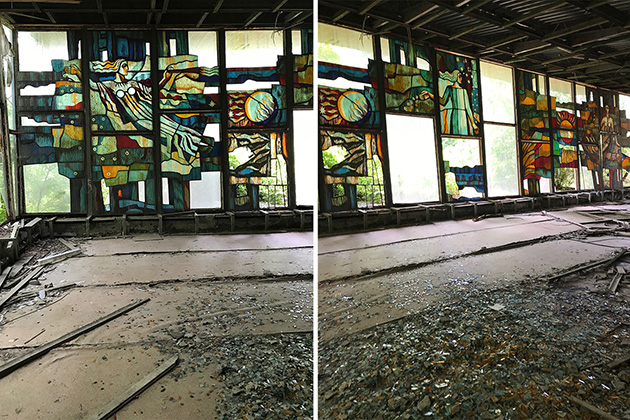
Here's What Chernobyl Looks Like Now

Chernobyl Town Sign
Founded in the 12th century, Chernobyl was a small town in northern Ukraine with a population of around 14,000 people before the disaster. It served as the administrative center for the surrounding region.
Following the 1986 disaster, the town of Chernobyl was evacuated within 36 hours due to the high levels of radiation. Residents were given little notice and belongings were left behind.
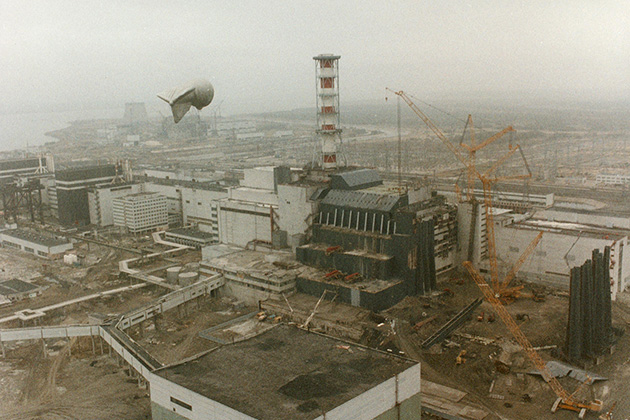
View of the Chernobyl Nuclear Power Plant After the Explosion on April 26, 1986
Around 31 people, mostly plant workers, perished from the initial blast and radiation exposure. A massive fire raged for several days, spewing radioactive material high into the atmosphere.
The town's fate became linked to the Chernobyl Nuclear Power Plant, built about 15 kilometers north of it in the 1970s. Chernobyl became a "closed town," meaning access was restricted to plant workers and their families.
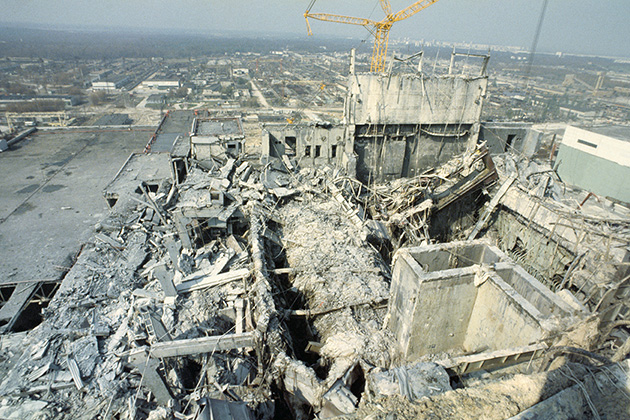
Debris After the Chernobyl Explosion
Firefighters were not aware just how deadly and dangerous the radiation was when they rushed in to contain the fire from the intial explosion. At least one would die days later from acute radiation poisoning.
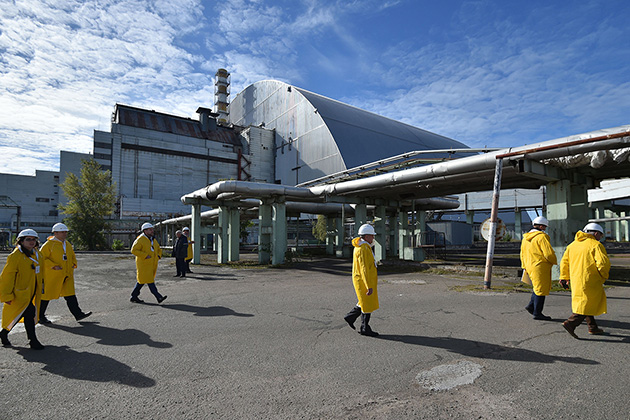
Preparing for the Opening of the New Power Plant in 2018
According to Getty Images, "the new plant has about 3,800 photovoltaic panels installed across an area of 1.6 hectares just a hundred metres from a giant metal dome, sealing the remains of the 1986 Chernobyl accident."

Dismembered Dolls Left Behind
When given the evacuation order, residents were only allowed to take a few important things with them. Much of what was left behind provides an eerie look into the everyday lives of these people.

A Dosimeter Showing Raditation Levels Near Abandoned Reactor 4 Statue
Built in the 1970s, Reactor 4 was part of a larger power plant with multiple reactors. Reactor 4 was a graphite-moderated, water-cooled RBMK-1000 reactor, a Soviet design with some inherent safety flaws.
Its design lacked a robust containment structure, a critical safety feature that would prevent radioactive material from being released in case of an accident. Additionally, the control rods used to regulate power had a design flaw that could worsen a power surge.
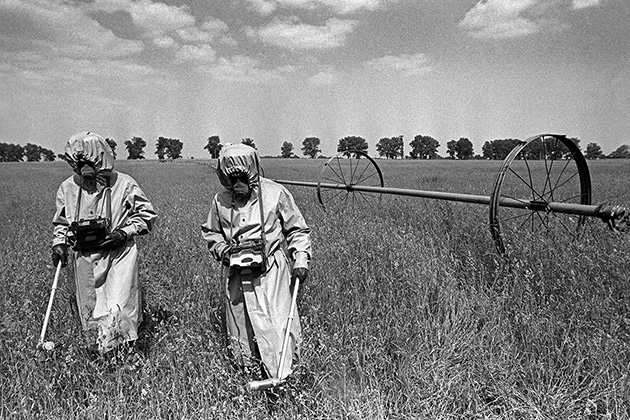
Liquidators Measuring Radiation Levels in the Chernobyl Aftermath
Fun fact: These "anti-chemical warfare suits" offer zero protection from radioactivity.
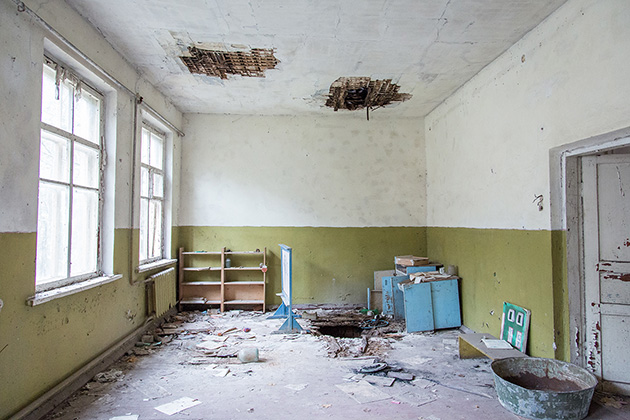
Inside the Kopachi Kindergarten
This Kindergarten building is the only building left standing in Kopachi village.
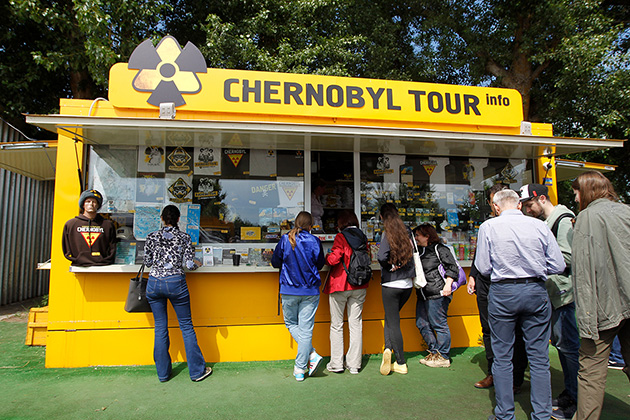
Chernobyl Tour
Chernobyl tours are up by 30% in 2019 compared to the previous year, thanks to HBO's show about the 1986 nuclear disaster.
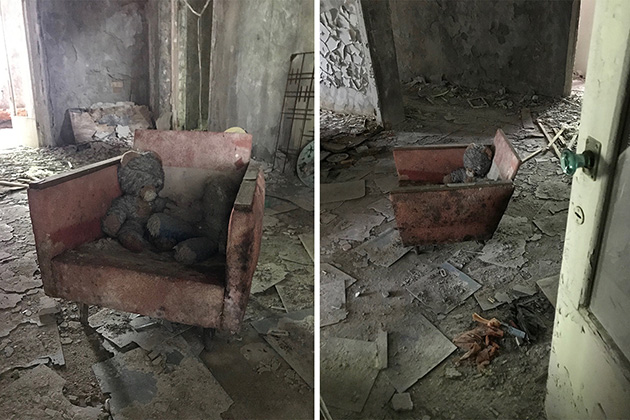
Abandoned Teddy Bears
Following the explosion, over 350,000 people were evacuated from their homes within a 30-kilometer radius of the power plant.
Children, especially those under 18 at the time of the accident, were particularly vulnerable to radioactive iodine released during the disaster.
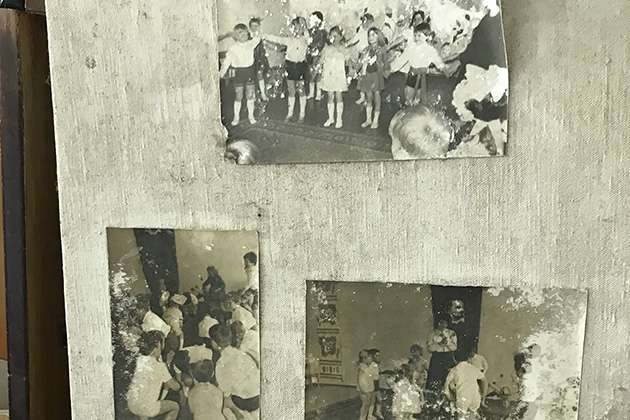
Old, Preserved Photographs
There are many stories of families who fled the Chernobyl disaster in such haste that they left behind many belongings, including family photos.
Many photos have been collected by Ukrainian artists in an attempt to preserve the photos and history of the town.
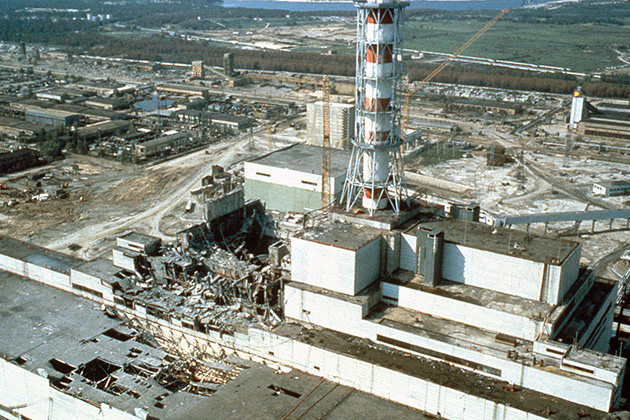
Chernobyl Nuclear Power Plant a Few Weeks After the Explosion
More radiation was released at Chernobyl than by the atomic bombs dropped on Hiroshima and Nagasaki.
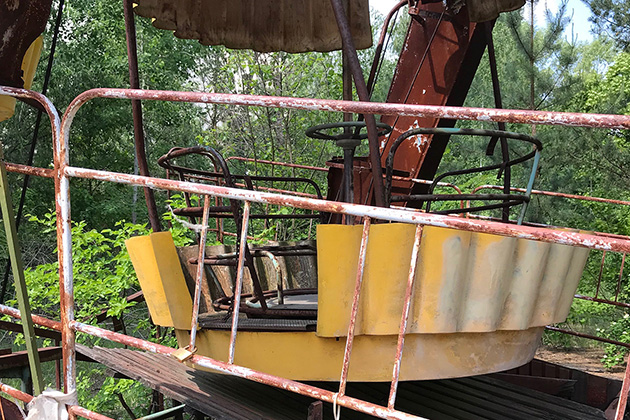
Old, Abandoned Ride
The abandoned amusement park in Pripyat, Ukraine, is one of the most haunting and iconic images of the Chernobyl disaster.
uilt in anticipation of the May Day celebrations in 1986, the park was never actually opened to the public.
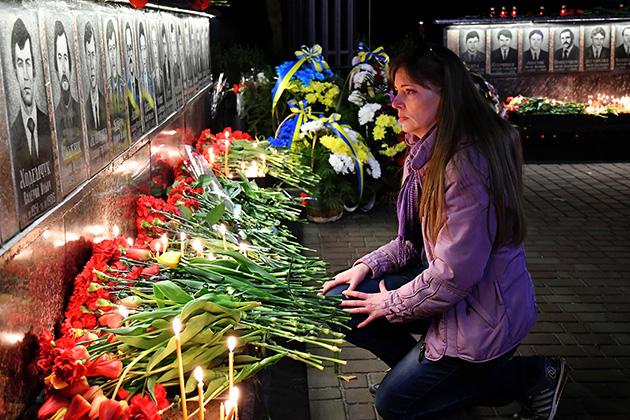
A Woman Pays Her Respects to the Chernobyl Victims in Slavutych
April 26, 2019 marked the 33rd anniversary of the Chernobyl disaster.
Official ceremonies are held annually on the anniversary of the disaster to remember the victims and the emergency workers who responded to the accident. These ceremonies often take place in Ukraine, Belarus, and Russia, the countries most affected by the disaster.
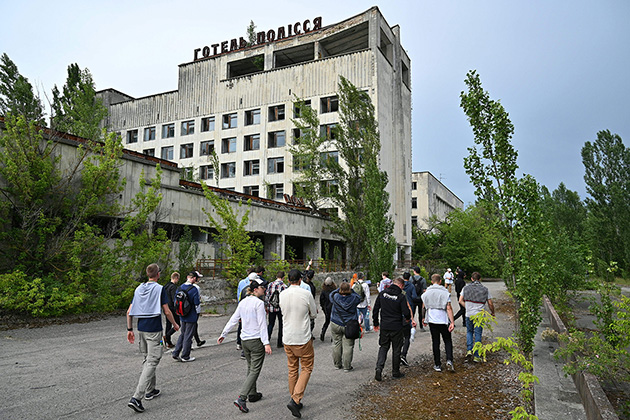
Visitors Take a Tour of Chernobyl
Although Chernobyl tours are generally safe, visitors are encouraged to wear plenty of clothing (no shorts or open-toed shoes) and avoid sitting or touching anything.
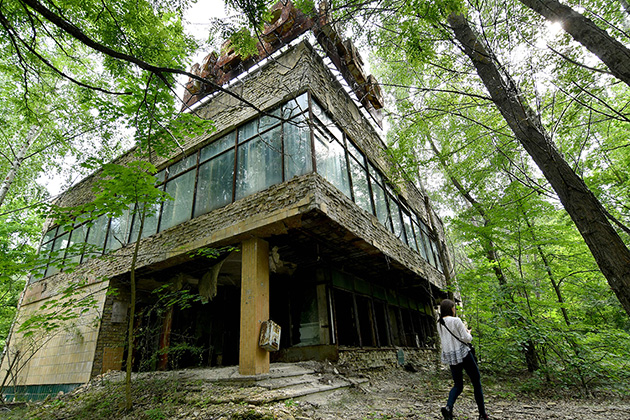
An Abandoned Building on the Chernobyl Tour
Chernobyl, a city forever frozen in time after the 1986 nuclear disaster, has become an unlikely tourist destination.
Tours of the site offer a basic exploration of the Chernobyl Exclusion Zone, typically lasting around 8-10 hours. They usually include visits to the abandoned city of Pripyat, the Chernobyl power plant (from a safe distance), and other significant sites.
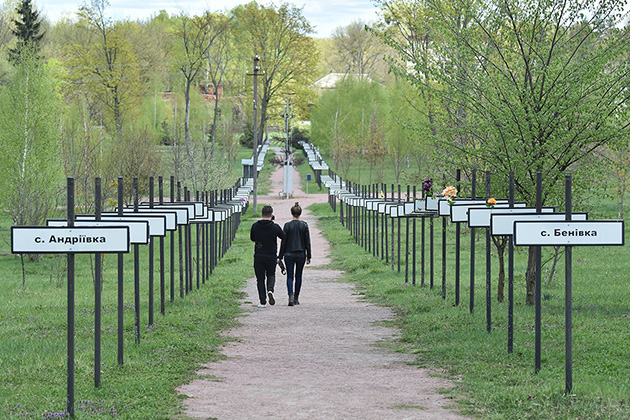
Chernobyl Alley of Names
This alley is a memorial to villages and towns that had to be evacuated after the Chernobyl disaster.
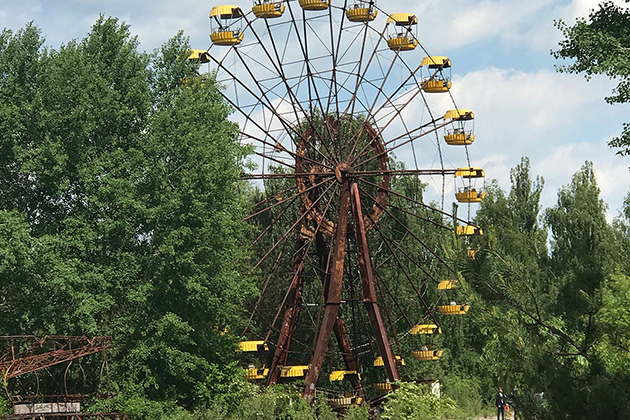
Abandoned Ferris Wheel In Chernobyl
The Chernobyl explosion stopped the grand opening of the amusement park, which was scheduled just a few days later.
The Ferris wheel, bumper cars, and other rides sit abandoned and overgrown, slowly succumbing to the elements.
Stained glass windows are found in the administrative building of the Chernobyl Nuclear Power Plant, located a short distance from the city of Pripyat.
These eight stained glass windows were created by Mykola Linnik and installed in 1986, just months before the disaster. The windows depicted various scenes related to the history of energy production, from Prometheus stealing fire from the gods to the peaceful use of nuclear power in space exploration.
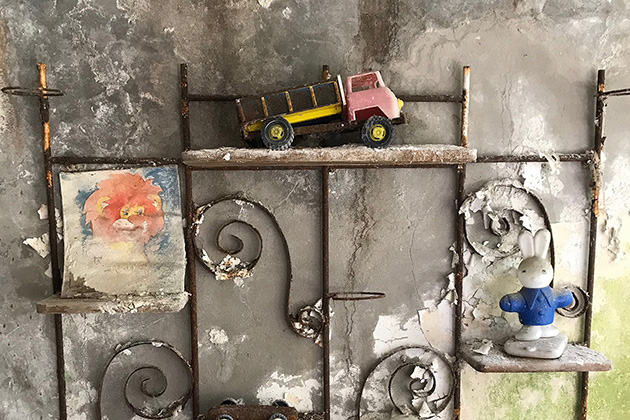
Abandoned Kids' Toys
The Chernobyl disaster had a significant impact on children's health, particularly those living in the surrounding areas of Belarus, Ukraine, and Russia.
Estimates suggest over 6,000 cases of thyroid cancer were reported in children and adolescents under 18 at the time, with the highest rates in Belarus.
More for You
'Big Bang Theory' Fans Congratulate Kaley Cuoco as She Announces Career Milestone
There are major changes coming for your washing machines and dryers
The States with the Most Coyotes in America
I'm an employment lawyer. Here are the first 3 questions to ask HR if you're laid off or fired.
Millionaire's illegal 'mancave' with bowling alley and cinema finally torn down
Is Victoria Beckham’s Diet Healthy? She Eats The 'Same Thing Every Day,' According To Her Husband David
Here’s why Americans drive on the right and the UK drives on the left
Reacher Season 3: Release, Plot, Cast & News
‘As confused as a goat on AstroTurf’: This retiree is mad his new spouse won't help pay for property taxes, maintenance and insurance — on a home she doesn't own. Who's right?
Fever legend Tamika Catchings takes issue with WNBA over Caitlin Clark 'cheap shot'
Cars To Avoid When Shopping: These 10 Models Have the Least Satisfied Owners
I want to retire a millionaire, so I showed my portfolio to a financial planner and he said 4 mistakes are holding me back
What happens if you don’t use your credit card?
Debunking 12 Myths About Trump's Conviction
Government announces controversial plan to exploit offshore wind farms for dirty energy exploration: 'It's like using a nicotine patch to roll a cigarette'
Fact Check: Do Photos Show USS Eisenhower Damage After Houthi Strike?
‘It’s scary what people are doing now’: Hawaii woman scrubs $1 bill, attempts to pass it off as $100. How to stretch your dollar without risking jail time
If you've been laid off or fired, here's what you should tell employers in your next job interview
This Abandoned Ford Dealer Is Filled With Perfectly Preserved '80s Cars
The Legendary King Ranch in Texas Is a Massive Marvel
Beyond Chernobyl: 7 Other Disaster Sites That Are Open For Tours In 2024
Chernobyl isn't the only disaster site open to visitors; these other sites of historical tragedies have also become accessible to the public.
- Tragic sites like Fukushima and Pompeii offer a unique glimpse into history, preserving the impact of devastating disasters.
- Tours provide an educational experience, highlighting resilience and impact while emphasizing safety precautions for visitors.
- Respectfully exploring dark tourism destinations can be an eye-opening journey of discovering the tragedies and their lasting effects.
The catastrophic Chernobyl disaster of 1986, one of the worst nuclear accidents in history, has transformed the exclusion zone into a haunting tourist destination, drawing visitors from around the globe. The disaster has affected many other cities in the region. Nowadays, there are still many questions about visiting Chernobyl and the surrounding area , especially regarding safety.
While Chernobyl is the most well-known disaster site open for tours, it is not the only one. Numerous other locations, marked by historical tragedies, have also become accessible to the public, offering a unique and often sobering glimpse into the past. These sites not only preserve the memory of the events but also educate visitors about the resilience of the affected communities and the enduring impact of these disasters.
10 Must-Visit Historical Ghost Towns Of The American West
7 pompeii, italy (79 ad), mount vesuvius' eruption destroyed this ancient city.
Pompeii is arguably the most famous disaster site of the ancient world. The ancient Roman city near modern Naples was famously destroyed by the eruption of Mount Vesuvius in 79 AD. The tragedy buried Pompeii under volcanic ash, preserving its buildings, artifacts, and even the forms of its residents in remarkable detail.
Today, Pompeii is a UNESCO World Heritage Ste open to visitors, offering a fascinating glimpse into Roman life. Tourists can explore well-preserved structures and sites in Pompeii like the Forum, the amphitheater, and numerous villas adorned with intricate frescoes, particularly the famous Villa of the Mysteries, one of the best preserved Roman Villas of Pompeii .
The site also features plaster casts of the eruption's victims, providing a poignant reminder of the city's sudden destruction. Tours typically last up to three hours and involve walking on uneven terrain.
I Visited Pompeii: How To Make The Most Of It As A First-Timer
6 plymouth, montserrat (1995-1997), the place is often referred to as modern-day pompeii, as it was devastated by several volcanic eruptions.
Plymouth, the former capital of Montserrat, was devastated by a series of volcanic eruptions from the Soufrière Hills volcano beginning in 1995 . The eruptions buried the city under layers of ash and pyroclastic flows, leading to its abandonment and transforming it into a modern-day Pompeii.
Despite the tragedy, Montserrat is open to visitors who can tour the exclusion zone with guides. Sightseers can observe the ash-covered remains of Plymouth, the partially buried buildings, and the now silent but imposing volcano.
The Montserrat Volcano Observatory provides educational exhibits and a safe vantage point for viewing the dramatic landscape changes.
Minor ashfall can occur occasionally . Travelers must be prepared with dust masks and eye protection, especially if hiking near the volcano.
5 Ancash, Peru (1970)
An earthquake triggered landslides that killed thousands of people.
In 1970, the Ancash region of Peru experienced a devastating earthquake, triggering a massive landslide on Mount Huascarán . This catastrophic event buried the town of Yungay and surrounding villages, killing approximately 70,000 people. The tragedy left a profound impact on the region, with only a few survivors.
Today, the area is open to visitors, who can see the remnants of Yungay, including the preserved cemetery and the Christ statue that miraculously survived the disaster. The Huascarán National Park , a UNESCO World Heritage Site, offers trekking opportunities and a sad reminder of the area's tragic history.
Huacachina: Visit The Most Stunning Oasis In Peru
4 fukushima daiichi nuclear power plant, japan (2011), the plant was struck by a tsunami, which triggered meltdowns in many reactors.
The Fukushima Daiichi Nuclear Power Plant , once a major electricity supplier, became synonymous with disaster in 2011. A massive earthquake triggered a tsunami that struck the plant, causing meltdowns in several reactors. Extensive radioactive contamination spread, forcing the evacuation of nearby towns.
Today, Fukushima and the surrounding area remains a carefully managed exclusion zone . Rigorous decontamination efforts are ongoing, with some areas deemed safe for controlled tours. These tours, led by qualified companies with strict safety protocols, allow visitors to witness the plant exterior and designated areas outside the exclusion zone.
Fukushima serves as a reminder of nuclear power's potential dangers while showcasing ongoing efforts towards decommissioning and a future beyond this disaster.
Radiation exposure risks are extremely low in these areas, but it is crucial to choose tours with a proven safety record.
3 Johnstown Flood National Memorial, Pennsylvania (1889)
This disaster caused by a dam failure killed over 2,200 people.
This site honors the victims of the 1889 Johnstown flood , a devastating event caused by a dam failure. The flood unleashed a wall of water that swept through the town, claiming over 2,200 lives and causing widespread destruction.
Tours explore the ruins and reconstructed town of Waldheim, showcasing how it was rebuilt on higher ground to prevent future disasters. Visitors can also walk along the South Fork Dam breach, a stark reminder of the event's power. The National Park Service offers ranger-led tours and interpretive exhibits, providing historical context and highlighting the importance of preparedness.
7 Dark Tourism Destinations To Add To Your Bucket List
2 hiroshima peace memorial park, japan (1945), this area honors the victims of the tragic atomic bombing.
A somber yet crucial site, the Hiroshima Peace Memorial Park commemorates the atomic bombing of Hiroshima in 1945. The Hiroshima Peace Memorial Museum exhibits artifacts and personal stories, offering a chance to learn about the devastating impact of the bomb and the ongoing fight for peace.
The park also features the Hiroshima Peace Memorial Flame , lit in 1964 and meant to burn until nuclear weapons are abolished. Self-guided tours are available, with English information panels throughout the park. Travelers can consider joining a guided peace walk for a deeper understanding of the event's historical and social context.
Is Hiroshima Still Radioactive? 10 Things To Know In The Modern Day
1 galveston, texas, 1900, more than 8,000 people died in a hurricane.
Galveston is a coastal city often remembered for its great beaches . Yet, the city also has a tragic past. In 1900, it was vanished by a hurricane, considered one of the deadliest natural disasters in U.S. history . The hurricane caused widespread destruction, with a storm surge that tragically claimed over 8,000 lives.
Visitors can explore the Galveston Seawall , a massive seawall system built after the disaster to protect the city from future storms. People can also explore the Galveston Historic District , where restored buildings showcase the city's architectural heritage and its remarkable recovery efforts. Many walking and trolley tours are available, offering insightful commentary on the city's history.
Avoid visiting during the hurricane season, which runs from June to November.

IMAGES
VIDEO
COMMENTS
Inside Chernobyl Reactor 4 Control Room and walking on top of its twin Reactor 3 filmed in July 2020 #Chernobyl35 ️ PLEASE LIKE, SHARE AND SUBSCRIBE ️☢️ Wat...
The control room of reactor 4 at the Chernobyl nuclear power plant—one of most ominous places on Earth—has become tourist attraction. ... The tour option is part of big changes at the site of ...
The control room of Chernobyl's highly radioactive Reactor No. 4 is now open to the public ©Chernobyl Tour. The control room of Chernobyl's reactor No. 4 is the epicentre of the worst-ever civil nuclear disaster in history. Thirty-three years ago, on that awful night of 26 April 1986, a series of explosions destroyed the reactor, killing at ...
The Telegraph was the first foreign media outlet to visit the Chernobyl control room, a few dozen feet away from the reactor that blew up and would become on...
The first episode of the new series from the long-term Chornobyl insiders! Today we will talk about the Chornobyl nuclear power plant and walk together throu...
Visit the Chernobyl Nuclear Power Plant control room 4 ⛔️ Gain firsthand knowledge from the experts regarding the Chernobyl accident, Inside Chernobyl reactor 4 control room ☢️ Enter the room where the worst nuclear disaster happened. ... The Chernobyl Online Virtual Tour is an online experience, where you together with us, ...
The radiation level will increase further as you enter the legendary Control room of reactor number #4 via your online lens. Dusty, empty, and radioactive, with equipment disassembled for the investigation purposes. Listen to the stories by the living legends of the Chernobyl Power Plant, with a perspective from the same spot from where one of ...
Chernobyl tour agencies confirmed to the network that the control ... The "highly radioactive" control room at Chernobyl Nuclear Power Plant's Reactor 4 at the center of the facility's ...
Chernobyl once sat at the centre of a 1,000-square-mile exclusion zone implemented after the 1986 catastrophe, but much of the area has been open to tourists since 2011. Chernobyl to become ...
5 person - $420.00 / person. Tour description. - Tour includes excursion around Chernobyl Nuclear power plant with entrance to the control room of the 4th exploded reactor (4 hour excursion) + private exploration of Pripyat ghost town and Duga radar (Russian Woodpecker) - It'll be just You alone or with the people You know.
The radiation in the room is 40,000 times higher than normal levels. Tourists can now visit the control room of Chernobyl's Reactor 4, the scene of the world's worst nuclear disaster. But the ...
Tours to the Chernobyl nuclear power plant - ChNPP-TOUR Tours inside ChNPP A breathtaking trip to the place of the world-known nuclear disaster. 4,5 hours inside the Chornobyl nuclear power plant, walk around the ghost- town of Prypiat and other sites and locations of the Zone of your choice.
Price: $149. Chernobyl nuclear power plant tours have become a popular tourist destination due to the apocalyptic looks of the area and the atmosphere of silence. Locations: -. - Huge secret radar and the. - Almost fully buried under the ground village. - covered by the new safe confinement -. - The with. -.
Tours. It's been 34 years since the Chernobyl reactor #4 exploded and caused the biggest nuclear fallout in humans history. Being covered with a large temporary concrete sarcophagus, and later with a proper giant protective steel dome, the RBMK reactor and its premises around were untouched and unseen by tourists.
Read More. The eerie interior of Chernobyl's Reactor 4 control room, the site of the devastating nuclear explosion in 1986, is now officially open to tourists—as long as they're willing to ...
The Chernobyl disaster was caused by a nuclear accident at the 4th reactor in the Chernobyl Nuclear Power Plant. The accident occurred on Saturday 26 April 1...
The icon indicates free access to the linked research on JSTOR. Good news for today's morbid tourist on the go: Chernobyl's reactor 4 control room, where technicians tried and ultimately failed to prevent the worst nuclear disaster in history, is now open for tourists. Visitors must wear protective clothing, limit their stay to 5 minutes ...
For anyone who's old enough to remember the 80's, the explosion of Reactor Number 4 in Chernobyl in 1986 was a terrifying moment - a horrifying realisation of all the fear that we felt around the looming threat of the Cold War. The standard tour to the area is a day trip but it is also possible to go for multiple days, staying in the ...
Top Tip: If actually going inside the power plant interests you, Chernobylwel.come do a 2 day Chernobyl Power Plant and Pripyat tour, as well as a Chernobyl Reactor 4 Control Room Tour. 8. Chernobyl Plant Canteen. After passing through a radiation checkpoint it's time to enjoy a traditional Ukrainian lunch.
The significance in the Chernobyl Nuclear Power Plant was of the reactor no.4 which turned out to be the dreaded one on the day of disaster. On 26th April 1986, the reactor no.4 was to be tested for cooling pumps generators. The idea behind the test was to allow the cooling pumps of the reactor no.4 which are assigned the task of cooling the ...
Chernobyl nuclear power plant with a monument near an administration building. Arch-shaped confinement that covered the Shelter object. The monument "To Those Who Saved the World". Where to Buy the Best Chernobyl Tour. Our company welcomes you to visit Chernobyl and Pripyat in reality without any danger for you.
Tour of Reactor 3 and 4 at the Chernobyl Nulear Power Plant.
Built in the 1970s, Reactor 4 was part of a larger power plant with multiple reactors. Reactor 4 was a graphite-moderated, water-cooled RBMK-1000 reactor, a Soviet design with some inherent safety ...
Chernobyl isn't the only disaster site open to visitors; these other sites of historical tragedies have also become accessible to the public. ... Tours provide an educational experience, highlighting resilience and impact while emphasizing safety precautions for visitors. ... 4 Fukushima Daiichi Nuclear Power Plant, Japan (2011) The plant was ...
Tags, Crazycars81, Crazy cars 81, chernobyl, Crazy cars 81 chernobyl, Nuclear power plant